Di seguito abbiamo raccolto un elenco di oltre 100 razze di polli.
Per ogni razza descriviamo il loro temperamento e la capacità di deporre le uova in modo da poter trovare il pollo perfetto.
Abbiamo persino creato uno strumento per aiutarti a trovare il pollo perfetto.
Che tu stia cercando un superbo strato di uova, uno splendido uccello da esposizione o un animale domestico, questo articolo dovrebbe avere qualcosa per te.
Molte delle nostre selezioni sono in pericolo critico e necessitano di aiuto per la conservazione (forse troverai qualcosa che vorresti aiutare a conservare).
Qualunque sia la tua motivazione per leggere questo, speriamo che lo troverai utile e interessante...
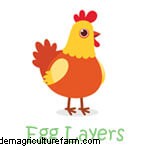
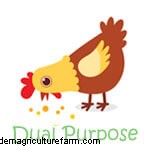
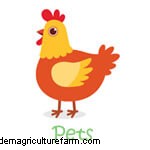
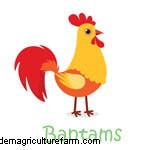
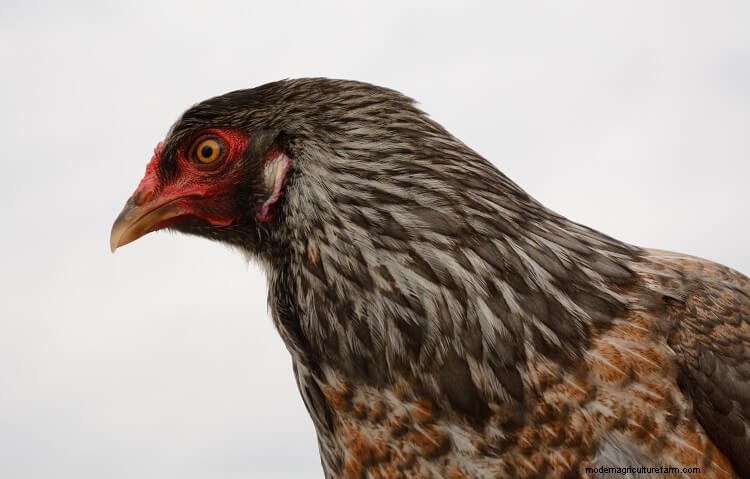
Gli Ameraucanas sono allevati dall'Araucana e sono deliziosi da vedere.
Il loro piumaggio è multicolore e hanno anche barbe e manicotti che conferiscono loro un aspetto insolitamente soffice.
Le galline adulte pesano circa 5 libbre o giù di lì, ma se vuoi più piccole arrivano anche in dimensioni bantam. La loro principale pretesa di fama è deporre uova blu . Sono ovaiole decenti che producono 3-4 uova a settimana.
Per quanto riguarda la loro personalità, sono amichevoli, intelligenti, curiosi e si comportano bene con i bambini.
Sono abbastanza silenziosi da poter stare anche in un ambiente urbano.
| Ameraucana |
|---|
| Uso principale: Uova |
| Produzione annuale di uova: 175-250 |
| Colore uovo: Blu |
| Adatto ai principianti: Sì |
| Temperamento: Amichevole |
| Livello di rumore: Normale |
| Clima preferito: Qualsiasi |
Questa razza è originaria dell'Italia e ha la forma classica di una razza mediterranea.
Possiede un bel piumaggio screziato bianco e nero che migliora con l'età.
Sono un pollo resistente che può deporre durante l'inverno producendo 4-5 grandi uova bianche a settimana.
Con questa razza puoi aspettarti una gallina attiva che non tollera bene il parto. Sono amichevoli con i loro umani e possono essere molto loquaci.
Sono uno strato a maturazione precoce con un buon rapporto di conversione del feed.
Quelli di dimensioni standard peseranno circa 6 libbre, ma sono disponibili anche in dimensioni bantam.
| Ancona |
|---|
| Uso principale: Uova |
| Produzione annuale di uova: 175-250 |
| Colore uovo: Bianco |
| Adatto ai principianti: Sì |
| Temperamento: ombroso |
| Livello di rumore: Normale |
| Clima preferito: Qualsiasi |
L'Andaluso è un'altra razza mediterranea.
Le loro origini esatte sono sconosciute, tuttavia sappiamo che sono abbastanza antiche in quanto furono custodite dai romani.
Meglio descritti come dignitosi ed equilibrati, sono anche amichevoli e curiosi . Vivono all'aperto poiché la reclusione ravvicinata li renderà volubili, nervosi e nevrotici.
Troverai più comunemente questa razza in blu. In effetti, molte persone conservano gli andalusi per il loro gene blu dominante incompleto e lo usano per ricaricare le piume blu in altre razze. Una volta cresciuta, peserà circa 5 libbre (sono disponibili varietà di bantam).
Le galline sono uno strato moderatamente buono di grandi uova bianche (circa tre uova a settimana).
| Andaluso |
|---|
| Uso principale: Uova |
| Produzione annuale di uova: 100-170 |
| Colore uovo: Bianco |
| Adatto ai principianti: No |
| Temperamento: Amichevole |
| Livello di rumore: Forte |
| Clima preferito: Climi caldi |
Incontra l'Appenzeller Spitzhausen.
È l'uccello nazionale della Svizzera e, come puoi immaginare, sono molto resistenti al freddo!
L'Appenzeller è un pollo piccolo e attivo che è un ottimo raccoglitore.
Queste galline hanno una personalità molto indipendente e sono intelligenti e sempre vigili. Possono essere molto rumorosi, quindi la vita urbana non sarebbe adatta a loro.
Le varietà di colore argento, oro e camoscio sono le più popolari, tuttavia questa gallina rimane rara negli Stati Uniti.
Aspettati che depongano circa tre uova di colore bianco medio a settimana.
| Appenzeller |
|---|
| Uso principale: Uova |
| Produzione annuale di uova: 100-170 |
| Colore uovo: Bianco |
| Adatto ai principianti: No |
| Temperamento: Amichevole |
| Livello di rumore: Forte |
| Clima preferito: Qualsiasi |
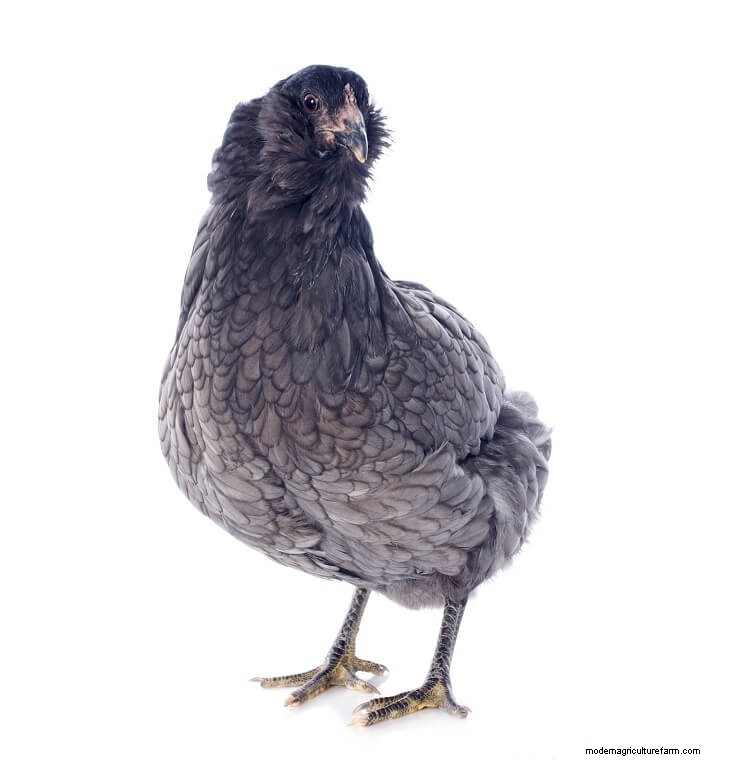
Originaria del Cile, questa razza è stata trovata viva tra gli indiani Mapuche.
Si pensa che sia un mix di due razze più vecchie (la Collonca e la Quetros).
L'Araucana ha un aspetto decisamente diverso. Non ha groppa e ha strani ciuffi che sporgono dalle orecchie. Questi ciuffi sembrano un po' stravaganti, ma il gene che li produce può essere mortale per i pulcini. Circa il 25% di tutti i pulcini Araucana morirà nel guscio a causa del gene del tufting.
Le Araucanas sono meglio descritte come amichevoli, tranquille e buone con i bambini. Preferiscono essere attivi ma tollereranno la reclusione.
Sono strati decenti di tre uova azzurre di medie dimensioni ogni settimana.
Lei è lo strato di uova blu originale.
Le galline hanno la tendenza a covare e fare delle brave madri.
Sono un uccellino che pesa circa 4-5 libbre per la gallina standard. Sebbene esistano, i bantam sono difficili da trovare.
| Araucana |
|---|
| Uso principale: Uova |
| Produzione annuale di uova: 100-170 |
| Colore uovo: Blu |
| Adatto ai principianti: Sì |
| Temperamento: Amichevole |
| Livello di rumore: Tranquillo |
| Clima preferito: Qualsiasi |
L'Austra White è una superstar della deposizione delle uova.
È stata allevata per la produzione di uova e deporrà oltre 4 uova grandi ogni settimana.
I loro genitori sono un gallo Australorp nero con una gallina livornese bianca.
Il gene Australorp aggiunge una certa dimensione al Livorno normalmente snello. Le galline possono gonfiarsi bene fino a circa 5 libbre e i galli fino a circa 6 libbre.
Sono descritti come calmi, docili e amichevoli, quindi si comportano bene con i bambini e non si oppongono all'essere presi in braccio.
Il loro piumaggio è per lo più bianco con occasionali macchie nere dappertutto.
| Austra White |
|---|
| Uso principale: Uova |
| Produzione annuale di uova: 250+ |
| Colore uovo: Bianco |
| Adatto ai principianti: Sì |
| Temperamento: Docile |
| Livello di rumore: Normale |
| Clima preferito: Qualsiasi |
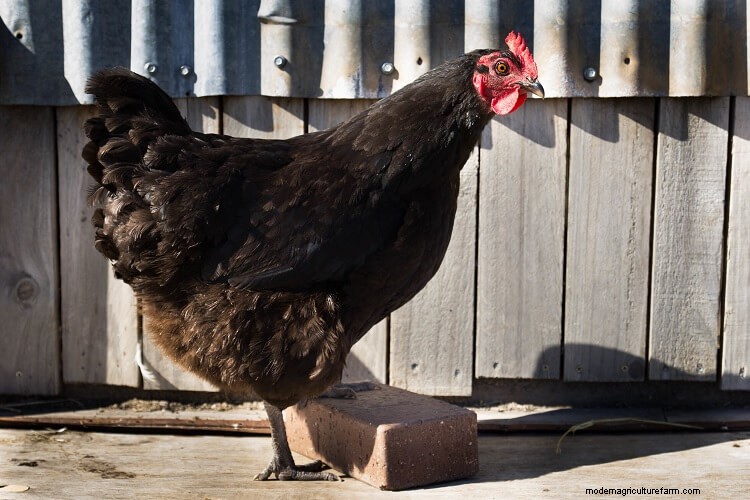
L'Australorp è stato creato in Australia incrociando Orpington con Rhode Island Reds, Minorcas e poche altre razze.
Questo ha creato una superstar della deposizione delle uova e gli Australorps sono l'uccello nazionale dell'Australia.
Le galline depongono 4-5 uova di colore marrone chiaro di medie dimensioni ogni settimana, con una media di circa 250 uova all'anno.
Sebbene inizialmente saranno timidi, diventerà curiosa e amerà indagare sulle cose.
Tipicamente il loro piumaggio è nero, tuttavia sono disponibili altre varietà.
Sono un pollo a bassa manutenzione che si adatta bene sia ai bambini che ai principianti.
| Australorp |
|---|
| Uso principale: Uova |
| Produzione annuale di uova: 250+ |
| Colore uovo: Marrone |
| Adatto ai principianti: Sì |
| Temperamento: Amichevole |
| Livello di rumore: Normale |
| Clima preferito: Qualsiasi |
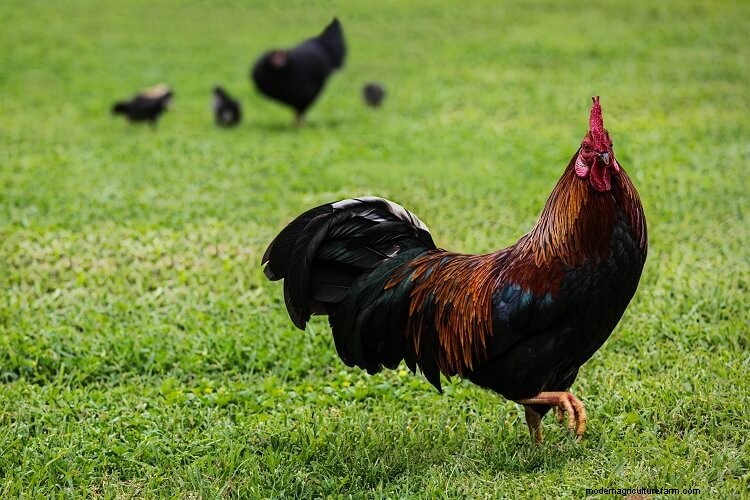
I Maran Black Copper sono diventati estremamente popolari grazie alle loro uova color cioccolato fondente.
Man mano che la stagione della deposizione continua, il colore delle uova diventerà più chiaro, tuttavia sarà ancora piuttosto scuro.
I Marans sono una combinazione di diverse razze riunite nella Francia occidentale all'inizio del 1900. Il loro piumaggio è di un nero accattivante (con iridescenze verdi) con le piume color rame.
Sono considerati una razza a doppio scopo e depongono circa 3 uova ogni settimana.
È una gallina tranquilla e gentile, generalmente abbastanza robusta e sana. Ci sono sia dimensioni standard (galline circa 6,5 libbre) che bantam. Tuttavia, i bantam sono incredibilmente rari e difficili da trovare.
| Marans Rame Nero |
|---|
| Uso principale: Uova |
| Produzione annuale di uova: 100-170 |
| Colore uovo: Cioccolato |
| Adatto ai principianti: Sì |
| Temperamento: Docile |
| Livello di rumore: Tranquillo |
| Clima preferito: Qualsiasi |
Conosciuto anche come Black Star, il Black Sex Link Chicken è uno dei polli più popolari in circolazione.
Tecnicamente non sono una razza, ma un ibrido. Sono un incrocio tra un gallo Rhode Island Red o New Hampshire con una gallina Barred Rock. Quando i pulcini si schiudono, i maschi hanno un punto bianco sulla testa (quindi sono molto facili da fare sesso).
Sono popolari perché sono ottimi strati di uova di 5 uova marrone chiaro ogni settimana.
È una razza docile, amichevole e attiva che si affezionerà ai suoi allevatori.
| Collegamento di sesso nero |
|---|
| Uso principale: Uova |
| Produzione annuale di uova: 250+ |
| Colore uovo: Marrone |
| Adatto ai principianti: Sì |
| Temperamento: Docile |
| Livello di rumore: Normale |
| Clima preferito: Qualsiasi |
Il marrone Livorno è una delle varietà livornesi che sta bene in fattoria.
Questo è un pollo attivo, indipendente e intelligente che può volare bene.
Sono meglio conosciuti come raccoglitori pieni di risorse che sono economici da mantenere.
Brown Leghorns ti darà 3-4 grandi uova bianche ogni settimana. Non tendono a meditare, ma sono buone madri.
Originari dell'Italia hanno la corporatura slanciata mediterranea. Possono avere un pettine singolo oa rosa e possono anche avere lobi bianchi.
Purtroppo dovrebbero evitare la vita in città perché possono essere rumorosi.
| Livorno Marrone |
|---|
| Uso principale: Uova |
| Produzione annuale di uova: 175-250 |
| Colore uovo: Bianco |
| Adatto ai principianti: Sì |
| Temperamento: Grassetto (sicuro di sé) |
| Livello di rumore: Forte |
| Clima preferito: Climi caldi |
Il Campine è un'antica razza nobile del Belgio.
Si ritiene che fosse in circolazione in epoca romana, tuttavia da allora la popolarità è diminuita e ora sono considerati in pericolo di estinzione.
È una piccola gallina e pesa solo circa 5 libbre (sono disponibili anche varietà di bantam). Ne esistono due varietà:argento e oro.
Campines produce 3 grandi uova bianche a settimana.
Sono conosciuti come una razza attiva che ama il foraggiamento. È curiosa, intelligente e amichevole fino a un certo punto, ma non le piace essere trattenuta. Sono tolleranti a un'ampia gamma di climi, ma non si adattano bene alle zone molto fredde.
| Campine |
|---|
| Uso principale: Uova |
| Produzione annuale di uova: 175-250 |
| Colore uovo: Bianco |
| Adatto ai principianti: No |
| Temperamento: Grassetto (sicuro di sé) |
| Livello di rumore: Normale |
| Clima preferito: Qualsiasi |
Nonostante il nome, il Cherry Egger non depone uova color ciliegia!
Il nome si riferisce al colore del loro piumaggio.
Sono un ibrido con un genitore che è il Rhode Island Red e l'altro un New Hampshire Red.
Come ci si potrebbe aspettare da genitori che depongono uova così prolifici, sono anche ottimi ovaiole che danno 4-5 uova ogni settimana.
È una razza amichevole e docile adatta all'ambiente urbano.
Sono facilmente reperibili in molti incubatoi.
| Cherry Egger |
|---|
| Uso principale: Uova |
| Produzione annuale di uova: 250+ |
| Colore uovo: Marrone |
| Adatto ai principianti: Sì |
| Temperamento: Amichevole |
| Livello di rumore: Normale |
| Clima preferito: Qualsiasi |
The Cinnamon Queen è un altro nome per i Red Sex Link Chickens.
I Red Sex Link sono chiamati così perché puoi distinguere tra maschio e femmina alla schiusa (quindi non dovrebbero esserci galli accidentali)!
Sono un pollo ibrido che si comporta molto bene nella deposizione delle uova. Dovrebbe deporre nella regione di 5-6 uova ogni settimana.
Puoi aspettarti una razza amichevole, docile e facile da gestire.
Sono noti per essere silenziosi, quindi un ambiente urbano va bene per loro.
| Regina cannella |
|---|
| Uso principale: Uova |
| Produzione annuale di uova: 250+ |
| Colore uovo: Marrone |
| Adatto ai principianti: Sì |
| Temperamento: Docile |
| Livello di rumore: Tranquillo |
| Clima preferito: Qualsiasi |
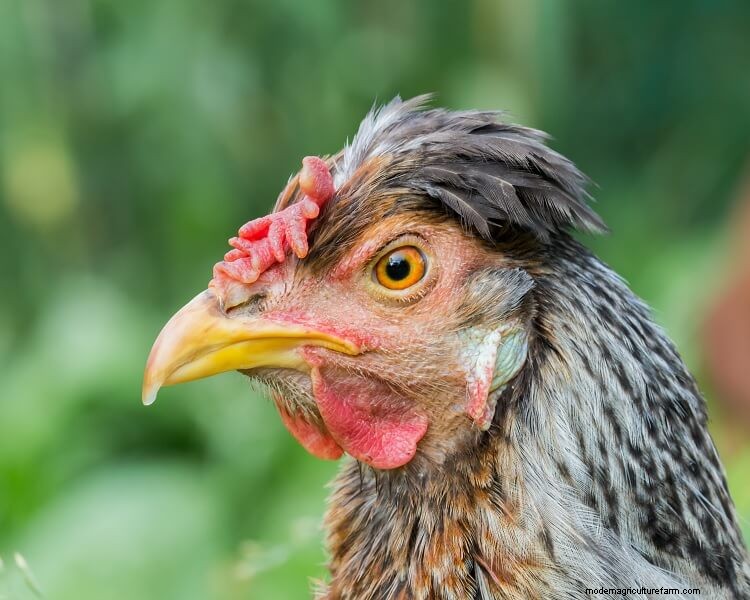
Il Cream Legbar è stato creato nel Regno Unito negli anni '30 dal professor Punnett. Stava cercando di creare un uccello che deponesse uova blu e che si auto-sessasse.
Ci è riuscito con il Legbar.
I pulcini possono essere sessati alla schiusa, quindi non dovrebbero esserci galli accidentali nel gruppo. Sono un buon strato di uova che danno 3-4 uova azzurre di medie dimensioni ogni settimana.
Le uova blu provengono dalla stirpe Araucana.
L'altro loro corredo genetico proviene da Livorno e Barred Rock.
In generale sono una razza amichevole e docile che è facilmente gestibile.
| Gambali crema |
|---|
| Uso principale: Uova |
| Produzione annuale di uova: 175-250 |
| Colore uovo: Blu |
| Adatto ai principianti: Sì |
| Temperamento: Amichevole |
| Livello di rumore: Normale |
| Clima preferito: Qualsiasi |
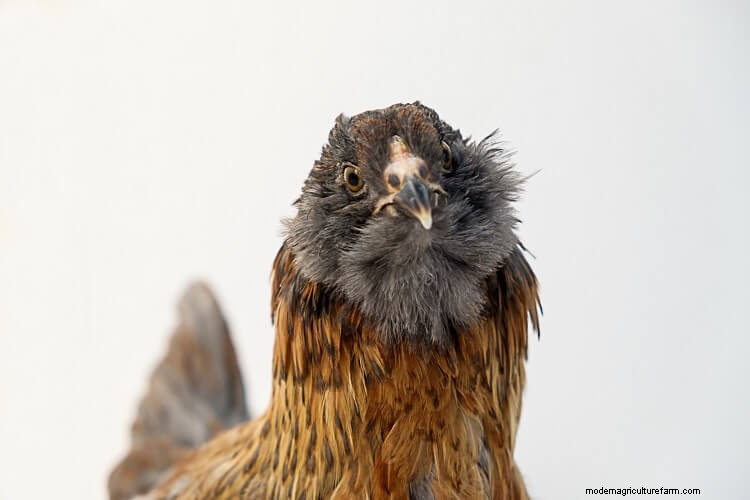
L'Egger Egger è una gallina allegra e felice.
Sono meglio conosciuti come una razza amichevole che è fantastica con i bambini e ama anche il tempo sul giro.
Sebbene questa razza sia tecnicamente un ibrido, sono molto ricercati a causa delle loro uova colorate.
Possono deporre uova di colore blu, oliva, verde e persino rosato . Qualunque sia il colore che depone la tua gallina, sarà l'unico colore che depone:non sono i singoli creatori di arcobaleno!
Tollera un'ampia gamma di temperature e climi e generalmente richiede poca manutenzione.
| Easter Egg |
|---|
| Uso principale: Uova |
| Produzione annuale di uova: 175-250 |
| Colore uovo: Arcobaleno (Altro) |
| Adatto ai principianti: Sì |
| Temperamento: Docile |
| Livello di rumore: Tranquillo |
| Clima preferito: Qualsiasi |
La Golden Comet è un altro ibrido Red Sex Link Chicken.
È stata utilizzata solo per l'industria del pollame, tuttavia questa adorabile signora è diventata una delle preferite del cortile.
Questa razza ha una personalità pacifica, calma e gentile. Amano i loro umani e bambini così come il tempo sul giro.
Sono delle superstar della deposizione delle uova dando 5-6 uova a settimana. Purtroppo essendo stati allevati per deporre le uova hanno solitamente una vita breve (meno di 5 anni).
È una gallina rustica e tollera sia i climi caldi che quelli freddi. Amano il campo libero ma tollereranno la reclusione con spazio sufficiente.
| Cometa dorata |
|---|
| Uso principale: Uova |
| Produzione annuale di uova: 250+ |
| Colore uovo: Marrone |
| Adatto ai principianti: Sì |
| Temperamento: Docile |
| Livello di rumore: Normale |
| Clima preferito: Qualsiasi |
Il pollo di Amburgo è stato fatto risalire all'Olanda del XIV secolo, dove si pensa che abbiano avuto origine. A volte sono conosciuti come Moonies a causa del loro piumaggio.
Sono una razza piccola, con galline che pesano solo 4 libbre.
La razza è piuttosto difficile da trovare ed è nell'elenco di controllo del bestiame.
La sua personalità è attiva e alquanto volubile:sono molto esperti di predatori e volano bene.
| Amburgo |
|---|
| Uso principale: Uova |
| Produzione annuale di uova: 175-250 |
| Colore uovo: Bianco |
| Adatto ai principianti: No |
| Temperamento: ombroso |
| Livello di rumore: Normale |
| Clima preferito: Qualsiasi |
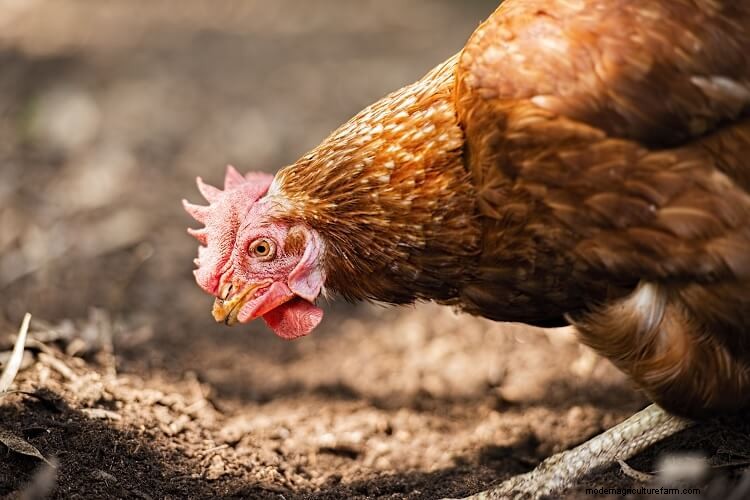
L'ISA Brown è stato allevato dall'Institut de Selection Animale.
Sono anche conosciuti come Hubbard ISA e il loro esatto corredo genetico è un segreto gelosamente custodito ed è stato brevettato nel 1978.
Le ISA Brown sono state allevate come macchine per la deposizione delle uova per l'industria del pollame e produrranno 5-6 uova marroni grandi ogni settimana per i primi 18 mesi circa, quindi la produzione diminuirà leggermente.
Purtroppo hanno una vita molto breve di 2-3 anni:tutta quella deposizione di uova è ruvida sul loro corpo.
Sono galline affettuose e spesso godono di un legame speciale con i loro umani con tanto tempo sul giro e coccole.
| ISA Brown |
|---|
| Uso principale: Uova |
| Produzione annuale di uova: 250+ |
| Colore uovo: Marrone |
| Adatto ai principianti: Sì |
| Temperamento: Docile |
| Livello di rumore: Normale |
| Clima preferito: Qualsiasi |
Creato negli anni '50 da un prete cattolico, l'Isbar è una razza relativamente nuova. Di conseguenza non sono ancora ammessi all'American Poultry Association.
Sono piccoli con galline che pesano 3-3,5 libbre. Possono essere usati come pollo a doppio scopo, ma sono più comunemente tenuti per le loro uova.
Aspettati una gallina intelligente, calma e accomodante che sia amichevole con i loro umani.
Le galline depongono 3-4 uova verdi ogni settimana:la profondità del verde può variare dalla salvia chiara al verde muschio.
Poiché sono stati creati in Svezia, tollerano abbastanza il freddo con una bella piuma densa.
Sono buoni raccoglitori e preferiscono ruspante al confinamento.
È interessante notare che sono anche auto-sessuati, il che significa che i pulcini possono essere sessuati alla schiusa.
| Isbar |
|---|
| Uso principale: Uova |
| Produzione annuale di uova: 175-250 |
| Colore uovo: Arcobaleno (Altro) |
| Adatto ai principianti: Sì |
| Temperamento: Docile |
| Livello di rumore: Normale |
| Clima preferito: Resistente al freddo |
Il Jaerhon è l'unica razza di pollo proveniente dalla Norvegia .
È stato sviluppato negli anni '20 dagli uccelli Landrace della Norvegia (tutti ora estinti).
Sono strati piccoli ma prolifici di uova bianche. Le galline non sono famose per la loro cova, quindi le loro capacità materne sono sconosciute.
Amano il campo libero e sono molto attenti ai predatori. Sono attivi, amano vagare e volare molto bene. Questa razza è amichevole con i suoi conduttori ed è anche tranquilla.
Il Jaerhon è disponibile in due varietà di colore:chiaro e scuro. Sorprendentemente c'è anche una varietà bantam.
| Jaerhon |
|---|
| Uso principale: Uova |
| Produzione annuale di uova: 250+ |
| Colore uovo: Bianco |
| Adatto ai principianti: Sì |
| Temperamento: Amichevole |
| Livello di rumore: Tranquillo |
| Clima preferito: Resistente al freddo |
Il Langshan fece la sua prima apparizione in Inghilterra alla fine del 1800 quando fu importato dalla Cina.
È un grande pollo a doppio scopo con un carrello molto verticale. Sono attivi e preferiscono il raggio d'azione, ma si comportano abbastanza bene in confinamento.
È interessante notare che sono l'unica gallina nota a deporre un uovo color prugna.
Le galline pesano circa 6,5 libbre e sono buoni ovaiole che producono 3 uova grandi a settimana.
Nel complesso sono calmi, docili e amichevoli con i loro umani.
| Langshan |
|---|
| Uso principale: Uova |
| Produzione annuale di uova: 100-170 |
| Colore uovo: Arcobaleno (Altro) |
| Adatto ai principianti: Sì |
| Temperamento: Docile |
| Livello di rumore: Normale |
| Clima preferito: Qualsiasi |
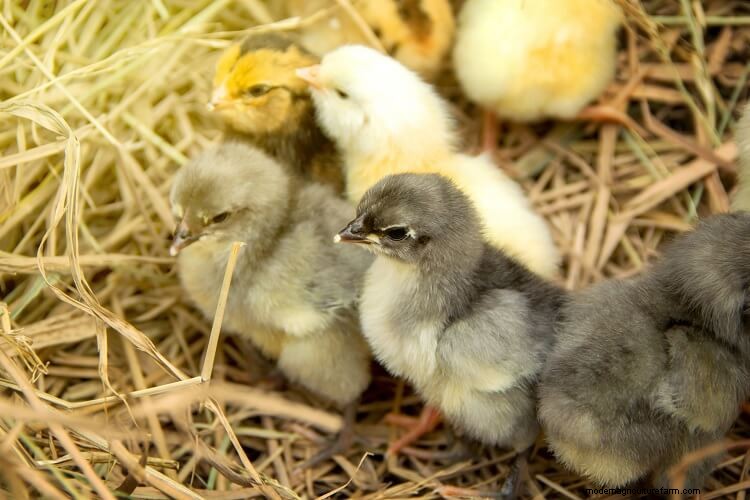
Le Olive Eggers sono tecnicamente un ibrido e sono un'introduzione abbastanza nuova nella scena dei polli.
Sono il risultato dell'incrocio di uno strato di uova marrone scuro con uno strato di uova blu (ad esempio una gallina ameraucana con un gallo Welsummer).
Il loro aspetto può variare, ma le galline deporranno un uovo color oliva.
Possono essere usati come doppio scopo (le galline pesano circa 5-6 libbre) ma di solito sono tenuti di più per le uova. Sono resistenti all'inverno e amano il foraggiamento, anche se tollerano molto bene il parto.
Questa è una gallina amichevole e docile che si comporta bene con i bambini.
| Olive Egg |
|---|
| Uso principale: Uova |
| Produzione annuale di uova: 100-170 |
| Colore uovo: Arcobaleno (Altro) |
| Adatto ai principianti: Sì |
| Temperamento: Docile |
| Livello di rumore: Normale |
| Clima preferito: Qualsiasi |
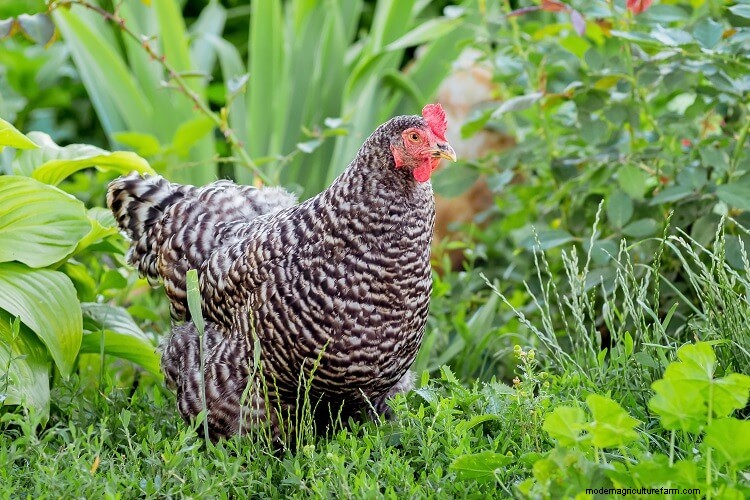
La Plymouth Rock è una delle razze più affidabili in circolazione oggi. È andata forte dal 1800 e rimane molto popolare oggi.
Questa razza non è così veloce da maturare come i polli industriali di oggi, ma vale la pena aspettare!
Le galline arrivano a 7 libbre e deporranno 4-5 uova di colore marrone chiaro.
Sono anche una razza autosessuata, il che significa che puoi distinguere i maschi dalle femmine non appena si schiudono.
Questa è una razza docile, curiosa e amichevole adatta ai bambini. Ci sono diverse varietà di colore tra cui scegliere e sono disponibili in dimensioni standard o bantam.
| Plymouth Rock |
|---|
| Uso principale: Uova |
| Produzione annuale di uova: 250+ |
| Colore uovo: Marrone |
| Adatto ai principianti: Sì |
| Temperamento: Docile |
| Livello di rumore: Normale |
| Clima preferito: Qualsiasi |
Il Red Sex Link è una razza ibrida.
Come ibridi sono stati selezionati per la deposizione delle uova, il che significa che depongono molto bene.
La maggior parte di loro fa deliziose galline da cortile. Sono amichevoli, docili e amano essere coccolati e tenuti in braccio, il che li rende perfetti per i bambini. Occasionalmente puoi ottenere ceppi aggressivi, ma è insolito.
Purtroppo questi polli hanno una vita breve (non molto più di 3 anni al massimo).
Puoi trovare Red Sex Links con una varietà di nomi:Golden Comet, Red Star, Bovans Brown e ISA brown solo per citarne alcuni.
| Link sessuale rosso |
|---|
| Uso principale: Uova |
| Produzione annuale di uova: 250+ |
| Colore uovo: Marrone |
| Adatto ai principianti: Sì |
| Temperamento: Docile |
| Livello di rumore: Normale |
| Clima preferito: Qualsiasi |
Le origini della gallina nera svedese sono incerte, ma quello che sappiamo è che questa razza è stata trovata in Svezia.
Questo è un uccello di razza autoctona che è un raro pollo fibromelanistico simile all'Ayam Cemani.
Conosciuti anche come Svart Hona, amano il ruspante e sono ottimi raccoglitori. Si divertono con i loro umani e spesso saltano in grembo per una sorpresa.
È una piccola gallina (che pesa circa 1 kg) e deporrà 3 uova grandi ogni settimana.
Nel complesso sono una razza che richiede poca manutenzione e possono tollerare il freddo e il caldo.
| Gallina nera svedese |
|---|
| Uso principale: Uova |
| Produzione annuale di uova: 100-170 |
| Colore uovo: Crema |
| Adatto ai principianti: Sì |
| Temperamento: Amichevole |
| Livello di rumore: Tranquillo |
| Clima preferito: Qualsiasi |
La gallina fiorita svedese era relativamente sconosciuta fino all'inizio degli anni 2000. È un uccello di razza autoctona che si è evoluto per sopravvivere in un paesaggio aspro.
Landrace significa che non c'è stata alcuna interferenza umana con la razza, quindi la diversità genetica è elevata.
A causa della loro diversità genetica possono essere crestati (o meno). I colori di base del piumaggio possono essere:nero, giallo o bianco, ma il motivo generale è mille fleur:questo dà loro un buon mimetismo contro i predatori.
Le galline sono ovaiole decenti e depongono 3-4 uova medie ogni settimana.
Sono una gallina sicura di sé e indipendente, ma sono amichevoli con i loro umani.
| Gallina da fiore svedesi |
|---|
| Uso principale: Uova |
| Produzione annuale di uova: 100-170 |
| Colore uovo: Crema |
| Adatto ai principianti: No |
| Temperamento: Docile |
| Livello di rumore: Tranquillo |
| Clima preferito: Resistente al freddo |
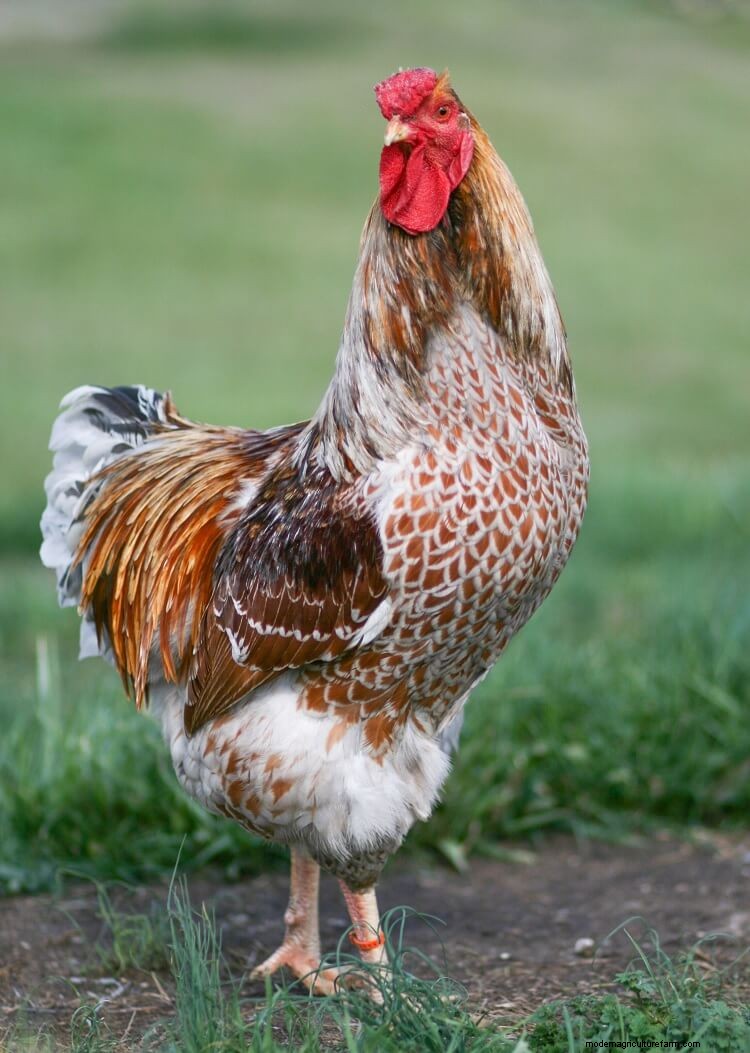
White Livorno è una varietà di colore del Livorno, un'antica razza italiana.
Essendo mediterranei hanno il tipico corpo snello e snello.
Sono una razza indipendente che è meglio descritta come rumorosa e volubile. Di certo non sono galline in grembo.
Esistono diverse varietà di Livorno ma il bianco è lo strato più prolifico . È noto che depongono 4-6 grandi uova bianche a settimana.
Il livornese preferisce un clima più caldo ma può tollerare climi freschi.
| Livorno bianco |
|---|
| Uso principale: Eggs |
| Yearly Egg Production: 250+ |
| Egg Color: White |
| Beginner Friendly: Yes |
| Temperament: Skittish |
| Noise Level: Loud |
| Preferred Climate: Warm Climates |
The White Rock is one of the Plymouth Rock varieties.
Created in the US as a dual purpose breed the Rocks are enduring success story. The White Rock has been a favorite with the broiler industry for many years.
It is a great chicken for small farms as it is people friendly and loves to be held which makes it great for kids and novices alike.
The hens are usually around 6lb in weight and good layers of large brown eggs (usually 4-5 per week).
They thrive in colder areas because of their dense feathering and are also available as bantams.
| White Rock |
|---|
| Main Use: Eggs |
| Yearly Egg Production: 250+ |
| Egg Color: Brown |
| Beginner Friendly: Yes |
| Temperament: Docile |
| Noise Level: Normal |
| Preferred Climate: Any |
The Whiting True Blue Chicken is a relatively new breed of chicken. It was created by Dr. Tom Whiting of Colorado in the late 1900s.
He created the chickens for two reasons:egg laying and fly tying.
Apparently the hackle feathers of the True Blue are of superb quality for tying fishing flies.
The hens are good layers and will give you 4 blue eggs each week.
True Blues are docile, curious and friendly towards humans. They are fast growing hens that are good flyers and love to be active. Their plumage is mixed colors with an occasional beard or single comb making an appearance.
| Whiting True Blue |
|---|
| Main Use: Eggs |
| Yearly Egg Production: 175-250 |
| Egg Color: Blue |
| Beginner Friendly: No |
| Temperament: Bold (Self Assured) |
| Noise Level: Normal |
| Preferred Climate: Any |
The Altsteirer is an ancient breed that can be traced back to at least the thirteenth century. They are also known as the Styrian as it was found in the Styrian region of Austria.
This is a very hardy and active dual purpose breed. They are constantly alert and love to free range and fly. Expect a friendly breed, but not lap chickens.
She will mature early and will weigh around 5.5lb.
The hens lay around three large white eggs each week and are not known for being broody.
There are two main varieties:white and partridge but there are other varieties too. All varieties are very rare.
| Altsteirer |
|---|
| Main Use: Dual Purpose |
| Yearly Egg Production: 100-170 |
| Egg Color: White |
| Beginner Friendly: Yes |
| Temperament: Friendly |
| Noise Level: Normal |
| Preferred Climate: Any |
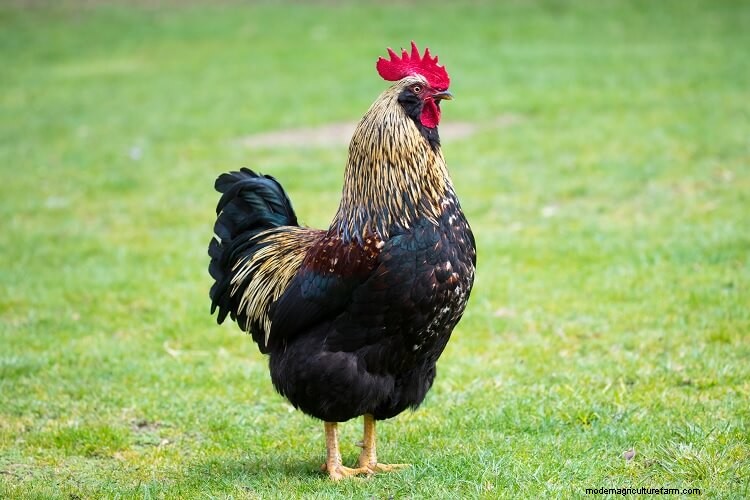
The Barnevelder was created in Holland specifically to lay a dark brown egg. Hens generally produce 3-4 large brown eggs each week (even through the winter).
They are a mix of several different breeds and are considered to be a dual purpose breed.
Once fully grown hens will lay around 5lb (there is a bantam variety too).
As for their personality they are calm and friendly with strong streaks of curiosity and intelligence.
They much prefer to be free ranging but will tolerate confinement pretty well as long as they have sufficient room and things to occupy them.
| Barnevelder |
|---|
| Main Use: Dual Purpose |
| Yearly Egg Production: 175-250 |
| Egg Color: Chocolate |
| Beginner Friendly: Yes |
| Temperament: Friendly |
| Noise Level: Normal |
| Preferred Climate: Any |
The Basque hen, also known as the Euskal Oiloa, originally comes from the Basque region of Spain.
This is a mountainous area where it is hard to survive. As a result Basque hens are hardy and a very thrifty forager.
There are five varieties with the Marraduna being the most common in the US.
These days it is a rare hen and efforts are being made to preserve this breed in their homeland. They are a remarkably friendly breed, and will not be afraid to jump into your lap to tell you about their day.
Hens will lay around 3 large brown eggs each week and will even lay during the winter.
| Basque |
|---|
| Main Use: Dual Purpose |
| Yearly Egg Production: 175-250 |
| Egg Color: Brown |
| Beginner Friendly: Yes |
| Temperament: Friendly |
| Noise Level: Normal |
| Preferred Climate: Warm Climates |

This is another member of the Wyandotte family that is currently popular. Although the blue lacing on red feathers seems to be the draw right now, this color variety can actually be dated back to the 1900s.
The Wyandotte is very well suited for cold climates as they have a rose comb and dense feathering to keep themselves warm through those long winter nights.
She is a large dual purpose hen and will weigh around 6lb.
Overall she is a peaceful, quiet and dependable breed, that lays 4 large cream/light brown eggs each week. Although they are docile they will not tolerate other breeds picking on them.
They do well in confinement as long as they have enough room, but prefer to free range when they can.
| Blue Laced Red Wyandotte |
|---|
| Main Use: Dual Purpose |
| Yearly Egg Production: 175-250 |
| Egg Color: Brown |
| Beginner Friendly: Yes |
| Temperament: Friendly |
| Noise Level: Quiet |
| Preferred Climate: Any |
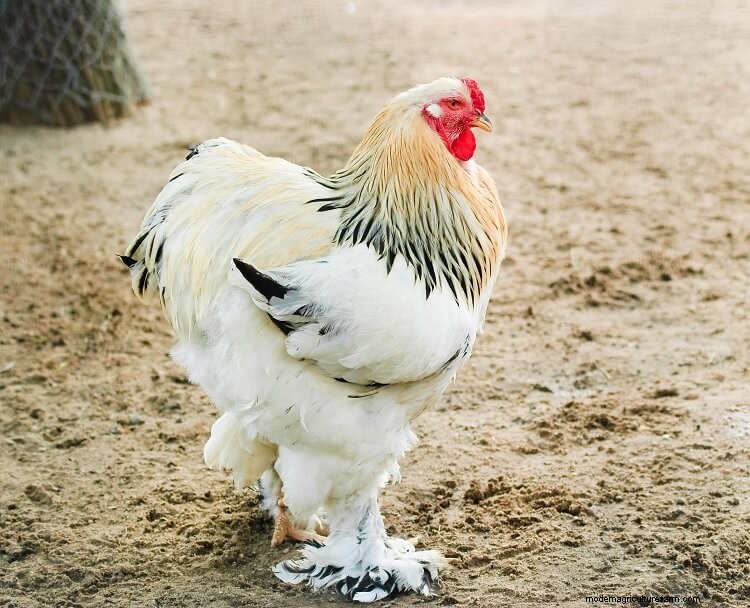
Welcome to the gentle giant of the chicken kingdom.
Brahmas can be huge with boys weighing up to 10lb and hens weighing 8lb!
Their personality is quiet, calm, docile and friendly. They are very tame and do well with children although their size can be a bit intimidating for some kids.
You can expect them to lay 3-4 medium brown eggs each week. And whilst they are not known for being broody, they do make good mothers.
The Brahma is available in both standard and bantam sizes.
| Brahma |
|---|
| Main Use: Dual Purpose |
| Yearly Egg Production: 100-170 |
| Egg Color: Brown |
| Beginner Friendly: Yes |
| Temperament: Friendly |
| Noise Level: Quiet |
| Preferred Climate: Any |
The Breda is the national bird of the Netherlands.
She is a striking breed and is truly without comparison in the poultry world.
Their head is shaped a bit like a crows’ head, with a large beak and cavernous nostrils. There is no comb just a red patch of skin and a small tuft
The Breda was very popular here in the US prior to the Civil War and then just faded away. They are slowly making a come-back but are considered endangered even in Holland.
Bredas weigh around 5-6lb and will lay 3 large white eggs each week. They are a shy chicken but are friendly, docile, alert and always curious.
| Breda |
|---|
| Main Use: Dual Purpose |
| Yearly Egg Production: 100-170 |
| Egg Color: White |
| Beginner Friendly: Yes |
| Temperament: Skittish |
| Noise Level: Normal |
| Preferred Climate: Any |
The Buckeye is the only American hen to have a pea comb . It is also the only breed that was created by a woman. They are called Buckeyes because their deep red plumage resembles the color of the buckeye nut.
They can thrive in cold climates because of their pea comb and tight feathering.
Buckeyes are more suited to free ranging, but should be kept in a safe area as they are not entirely predator savvy.
They are a good dual purpose breed, with hens laying 3-4 eggs a week.
She is an active breed and said to be great mousers. They are peaceful and friendly with their humans.
| Buckeye |
|---|
| Main Use: Dual Purpose |
| Yearly Egg Production: 175-250 |
| Egg Color: Brown |
| Beginner Friendly: Yes |
| Temperament: Docile |
| Noise Level: Quiet |
| Preferred Climate: Any |
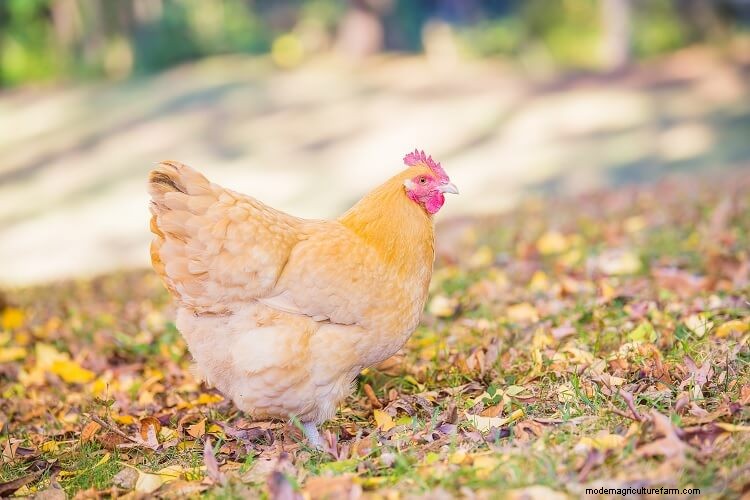
Welcome to the most popular variety of the Orpington tribe.
The Buff is loved all over the world and returns this love right back. She is a cuddly and calm breed that enjoys lap time and being picked up.
Buff Orpingtons are large chickens that weight around 8lb. She is a good layer putting out between 3-5 large light brown eggs per week.
The only negative thing to say about them is that they can be annoyingly broody, but if you want to raise chicks the Orpington will oblige.
Finally, they do need to be monitored for obesity as they are heavy feeders.
| Buff Orpington |
|---|
| Main Use: Dual Purpose |
| Yearly Egg Production: 175-250 |
| Egg Color: Brown |
| Beginner Friendly: Yes |
| Temperament: Friendly |
| Noise Level: Quiet |
| Preferred Climate: Any |
The Catalana originated in Spain and unusually for a Mediterranean breed is dual purpose.
Hens are good layers putting out 4 large white eggs a week and are rarely broody.
Unfortunately this breed has not caught on in the US yet, but they are very popular in Spain and Latin America.
She is known as an active and independent breed that loves to forage. They can be noisy so an urban environment is not for them. You will also notice she flys well and roosts high.
They come in two sizes:standard and bantam.
| Catalana |
|---|
| Main Use: Dual Purpose |
| Yearly Egg Production: 175-250 |
| Egg Color: White |
| Beginner Friendly: No |
| Temperament: Skittish |
| Noise Level: Loud |
| Preferred Climate: Warm Climates |
The Chantecler is Canadas first chicken breed.
They were bred in a Quebec monastery with the intention of producing a good dual purpose chicken that could survive the Canadian winters.
She tolerates the cold very well but does not like the heat so much.
Chanteclers have small wattles, a cushion comb and dense feathering. They come in two colors:white and partridge.
Overall they are a friendly and personable breed that is calm and gentle.
| Chantecler |
|---|
| Main Use: Dual Purpose |
| Yearly Egg Production: 175-250 |
| Egg Color: Brown |
| Beginner Friendly: Yes |
| Temperament: Docile |
| Noise Level: Quiet |
| Preferred Climate: Any |
The Colombian Wyandotte is one of the prettier Wyandotte varieties.
They are large birds and can weigh between 6-9lb.
In addition to this she is a good layer and will produce 4-5 large light brown eggs a week.
Hens do occasionally go broody and make attentive mothers.
Personality wise they are quiet, calm and docile. However they do not enjoy being picked up or held. They do equally well confined or free ranging but if they are allowed to roam they are great foragers.
They are suitable for an urban environment and come in standard and bantam sizes.
| Columbian Wyandotte |
|---|
| Main Use: Dual Purpose |
| Yearly Egg Production: 175-250 |
| Egg Color: Brown |
| Beginner Friendly: Yes |
| Temperament: Docile |
| Noise Level: Quiet |
| Preferred Climate: Any |
The Cuckoo Marans is one of several varieties of Marans chickens.
This French breed was developed over the centuries and an official standard was established in the 1920s.
The hens are very sought after because they lay chocolate colored eggs.
However they are not the most prolific layers, giving around 3 large per week.
This is a winter hardy chicken and a good forager. They are said to mature fairly quickly and once fully grown a hen will weight 7-8lb. They will tolerate confinement but prefer to free range.
| Cuckoo Marans |
|---|
| Main Use: Dual Purpose |
| Yearly Egg Production: 100-170 |
| Egg Color: Chocolate |
| Beginner Friendly: No |
| Temperament: Docile |
| Noise Level: Quiet |
| Preferred Climate: Any |
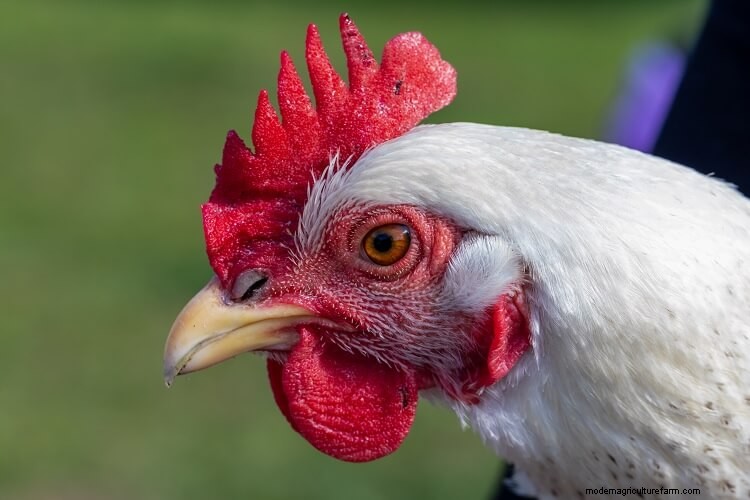
The Delaware was created around the 1940s and was destined to become the broiler chicken of the industry.
Originally called Indian Rivers they were extremely popular because they laid well and were fast growing. However they were surpassed in growth by the Cornish Cross, which became the broiler hen of the century.
Delawares are calm and curious hens that are personable and intelligent.
This sweet breed will be quite talkative too.
Available in both standard and bantam sizes this is a good homesteading breed. Hens will lay 4 large brown eggs a week and rarely go broody.
| Delaware |
|---|
| Main Use: Dual Purpose |
| Yearly Egg Production: 175-250 |
| Egg Color: Brown |
| Beginner Friendly: Yes |
| Temperament: Docile |
| Noise Level: Normal |
| Preferred Climate: Any |
The Red Cap is an old English breed. It is also known as a Coral cap.
They are an active but shy breed and are well suited for free ranging.
Derbyshire Redcaps are relatively pure since there has been little cross breeding with this breed. They have a stunning rose comb (hence the name Red Cap) and will reach around 6lb.
They were especially popular in the north of England however these days she is critically endangered.
The hens are not prolific layers but will give you a respectable 3-4 medium white eggs each week.
| Derbyshire Redcap |
|---|
| Main Use: Dual Purpose |
| Yearly Egg Production: 175-250 |
| Egg Color: White |
| Beginner Friendly: No |
| Temperament: Skittish |
| Noise Level: Normal |
| Preferred Climate: Any |
The Dominique hen is considered to be one of America’s oldest breeds.
They are also known as Pilgrim fowl as they are thought to have descended from the original breeds brought by the pilgrims.
She is a small hen and will only weigh around 5lb.
Their plumage is a black and white staggered barring pattern which helps them hide from predators. Their dense plumage and rose comb makes them a cold hardy breed.
In general they are a calm, docile and friendly breed. They are active, hardy and a fairly low maintenance breed.
Occasionally they will go broody and they make great mothers.
| Dominique |
|---|
| Main Use: Dual Purpose |
| Yearly Egg Production: 175-250 |
| Egg Color: Brown |
| Beginner Friendly: Yes |
| Temperament: Docile |
| Noise Level: Quiet |
| Preferred Climate: Any |
The exact history of the Dorking is unclear but they are thought to have originated from England. You may occasionally find this breed is called old five toes.
They evolved from the Landrace Chicken and remain a slow grower by today’s standards.
Hens will grow to around 6lb and Roosters will get heavier.
You should expect a shy and gentle chicken. They like to free range but will tolerate confinement fairly well.
They are one of the few hens with red earlobes that produce white eggs. They are attentive and devoted mothers and are quite broody.
| Dorking |
|---|
| Main Use: Dual Purpose |
| Yearly Egg Production: 175-250 |
| Egg Color: White |
| Beginner Friendly: No |
| Temperament: Docile |
| Noise Level: Quiet |
| Preferred Climate: Cold Hardy |
The Faverolles is an old French breed that is used as a dual purpose bird.
They have a happy personality, love to chat with you, are friendly, gentle and docile.
Their plumage is quite dense and they have beards, muffs and feathered feet which gives them an even fluffier appearance.
The most popular variety of Faverolles is the salmon color , which is more of a honey brown tone.
Hens are good layers of large tinted eggs. They do occasionally go broody and make good mothers.
The Faverolles love to free range but tolerate confinement with plenty of space.
| Faverolles |
|---|
| Main Use: Dual Purpose |
| Yearly Egg Production: 175-250 |
| Egg Color: Brown |
| Beginner Friendly: Yes |
| Temperament: Friendly |
| Noise Level: Normal |
| Preferred Climate: Any |
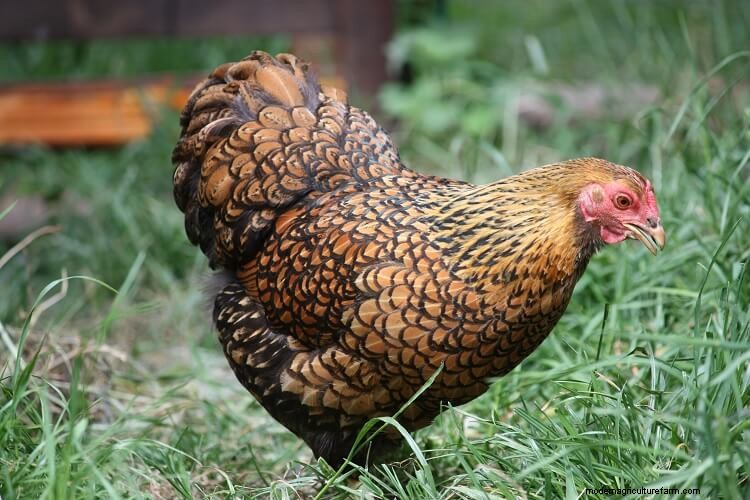
The Golden Laced Wyandotte is one of Americas’ premier breeds!
She is cold hardy, productive and low maintenance.
Once fully grown she will reach around 6lb, however if you are restricted with space then bantams are available.
They are an independent minded hen and prefer the company of their own breed. Whilst she is friendly enough to humans, she does not enjoy being picked up or cuddled.
Their independent nature and low maintenance requirements makes them ideal for novices and 4H programs.
| Golden Laced Wyandotte |
|---|
| Main Use: Dual Purpose |
| Yearly Egg Production: 175-250 |
| Egg Color: Brown |
| Beginner Friendly: Yes |
| Temperament: Bold (Self Assured) |
| Noise Level: Quiet |
| Preferred Climate: Any |
Icelandic chickens are a rare gem . They are almost genetically pure which seems to keep them pretty healthy and disease free.
They were left in Iceland by the Vikings who had selected the best utilitarian chickens they could find. As a Landrace Chicken there is no standard and they come in a wide variety of colors, patterns and plumage types.
As you would expect, they are great foragers and can virtually feed themselves. They are extremely hardy to most climates, fly well and very predator savvy.
Given their history this breed will never be cuddly, but they will become friendly and trusting of you if given time.
Hens will only weigh around 3lb.
| Icelandic |
|---|
| Main Use: Dual Purpose |
| Yearly Egg Production: 100-170 |
| Egg Color: White |
| Beginner Friendly: Yes |
| Temperament: Bold (Self Assured) |
| Noise Level: Normal |
| Preferred Climate: Cold Hardy |
Unfortunately the Iowa Blue is a rare breed these days.
They were created around the 1900s in Iowa and quickly gained popularity in small farms and homesteads.
This is a large breed that will weigh between 5-6lb. Hens are good layers and will give you 3-4 eggs each week. Also the ladies have a tendency towards broodiness and make good mothers.
Roosters are known for being great flock defenders and their nickname is hawk fighter!
The breed does best in a free range situation as it is a great forager and alert to danger.
You can expect a fairly calm and docile chicken that is tolerant of a wide range of temperatures and environments.
| Iowa Blue |
|---|
| Main Use: Dual Purpose |
| Yearly Egg Production: 100-170 |
| Egg Color: Brown |
| Beginner Friendly: Yes |
| Temperament: Docile |
| Noise Level: Normal |
| Preferred Climate: Any |
The Java is the second oldest breed in the US behind the Dominique. Despite their name they were developed in the US sometime around the mid-1800s.
They were critically endangered at one time but are slowly making a comeback.
She is very well suited to small farms and homesteads.
They are a dual purpose chicken and will lay 3 large brown eggs a week.
This breed loves to range and when allowed they will supplement their diet very well. You can find them in three varieties (black, white and mottled).
Expect a friendly, docile and calm breed that is easily handled.
| Java |
|---|
| Main Use: Dual Purpose |
| Yearly Egg Production: 100-170 |
| Egg Color: Brown |
| Beginner Friendly: Yes |
| Temperament: Docile |
| Noise Level: Normal |
| Preferred Climate: Any |
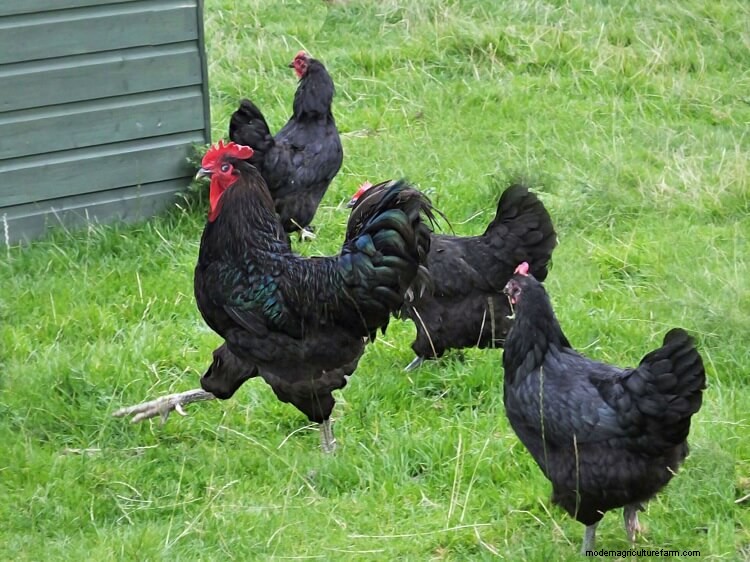
The Jersey Giant was created in New Jersey back in the 1800s.
It was originally intended to rival the turkey’s place at the table.
As you would expect this is a large chicken that stands around 2 feet tall. Males will weigh 13-15lb and hens around 11lb.
Given their size you will need to have larger pens, doors and nest boxes available for them. Also make sure to place perches slightly lower to the floor.
Jersey Giants are calm, gentle and love to forage. This is a good thing as they are expensive to feed so letting them roam will reduce their feed bill slightly. They are not known for being broody, but sadly when they do, they often break the eggs with their weight or step on the chicks accidentally.
They are suitable for beginners and children – although their size can be a bit intimidating!
| Jersey Giant |
|---|
| Main Use: Dual Purpose |
| Yearly Egg Production: 175-250 |
| Egg Color: Brown |
| Beginner Friendly: Yes |
| Temperament: Docile |
| Noise Level: Normal |
| Preferred Climate: Any |
The Lavender Orpington is one of the newer additions to the Orpington family.
They were first bred in the 1990s and have really taken off in popularity.
The Lavender color is due to a recessive diluting gene that dilutes black to a pale grey/pearl grey or lavender.
Orpingtons are large fluffy hens that look enormous. They are a dual purpose hen but the lavender strain often is an exhibition or show bird too.
Hens are notoriously broody and make great mothers and will raise most eggs placed under them. When they are not broody they will lay 3-4 large tinted eggs each week.
Orpingtons are inclined to be lazy and whilst they do forage they will prefer to sit by the feeder. Their weight should be monitored as obese hens can have serious problems with egg laying.
They are gentle, quiet, docile and make great beginner chickens.
| Lavender Orpington |
|---|
| Main Use: Dual Purpose |
| Yearly Egg Production: 175-250 |
| Egg Color: Brown |
| Beginner Friendly: Yes |
| Temperament: Docile |
| Noise Level: Quiet |
| Preferred Climate: Any |
The Light Brahma is a color variation of the Brahma.
They have a light colored plumage and are quite large. However despite their appearance they are a gentle giant!
Brahmas are calm, friendly and quiet, so are well suited for beginners.
The hens are good layers and will produce around 4 brown eggs per week.
| Light Brahma |
|---|
| Main Use: Dual Purpose |
| Yearly Egg Production: 100-170 |
| Egg Color: Brown |
| Beginner Friendly: Yes |
| Temperament: Friendly |
| Noise Level: Quiet |
| Preferred Climate: Any |
The Marsh Daisy is sadly in need of people to help conserve the breed.
She was created in the 1800s in Lancashire (England) and is a beautiful hen well suited to small farms and homesteads.
The name Marsh Daisy may come from their oversized rose comb which is said to look like a Marsh Daisy.
They are slow to mature but they are very economical since they love to free range and are very active foragers.
Although they cannot really be described as friendly, they are pretty calm yet aloof.
Hens weigh around 5.5lb and will lay 2-3 medium tinted eggs each week. They are occasionally broody and make good mothers.
They come in five color varieties but some are very rare and hard to find.
| Marsh Daisy |
|---|
| Main Use: Dual Purpose |
| Yearly Egg Production: 100-170 |
| Egg Color: Cream |
| Beginner Friendly: Yes |
| Temperament: Bold (Self Assured) |
| Noise Level: Normal |
| Preferred Climate: Any |
The Minorca was developed in the late 1700s and comes to us from the Balearic Islands of the Mediterranean.
Also known as the Moorish chicken, or the Red faced Black Spanish, they are the largest of the Mediterranean breeds standing tall with a long tail.
Notably they have large white earlobes and can have either a single or rose comb.
Hens have a good temperament and really enjoy their humans. They can still be a bit flighty on occasions but are generally calm and docile.
You can expect excellent foragers that prefer warmer climates.
| Minorca |
|---|
| Main Use: Dual Purpose |
| Yearly Egg Production: 175-250 |
| Egg Color: White |
| Beginner Friendly: No |
| Temperament: Skittish |
| Noise Level: Normal |
| Preferred Climate: Warm Climates |
The New Hampshire breed was created in the State of New Hampshire around 1918 as a dual purpose hen.
Unfortunately they have always been overshadowed by the Rhode Island Red which was created around the same time.
They are friendly hens that tend to make good pets and are easy to tame (so are ideal for kids). However they can be food aggressive with other breeds, so be careful when mixing with other breeds.
The hens weigh in at 6.5lb and are good layers of large tinted eggs. They also have a broody tendency and make great mothers.
New Hampshires come in both standard and bantam sizes, but both are hard to find.
| New Hampshire |
|---|
| Main Use: Dual Purpose |
| Yearly Egg Production: 250+ |
| Egg Color: Brown |
| Beginner Friendly: Yes |
| Temperament: Docile |
| Noise Level: Normal |
| Preferred Climate: Any |
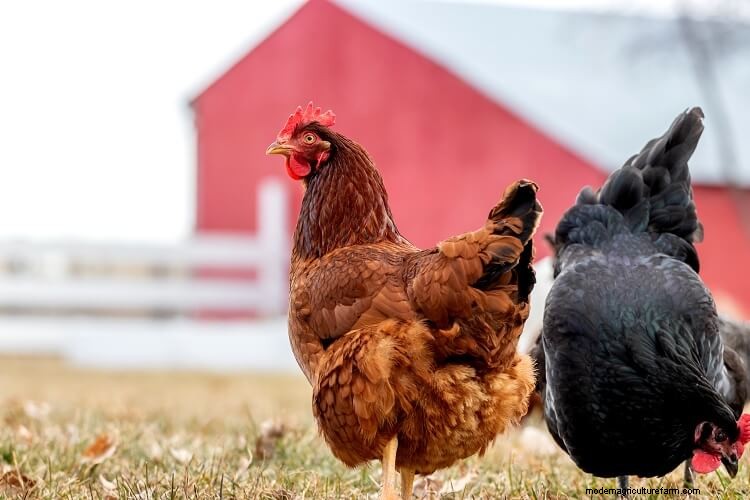
To this day the Orpington breed is a favorite of many small farms and backyard poultry enthusiasts.
This is a large dual purpose chicken that is a prolific egg layer.
She will make a great attentive mother too.
They are large and have copious feathering which comes in several varieties – buff is regarded as the favorite.
Orpingtons are docile, gentle and calm. They are quiet too so urban living could be for them.
This is a great hen for novices and children and will frequently become lap chickens.
| Orpingtons |
|---|
| Main Use: Dual Purpose |
| Yearly Egg Production: 175-250 |
| Egg Color: Brown |
| Beginner Friendly: Yes |
| Temperament: Docile |
| Noise Level: Quiet |
| Preferred Climate: Any |
The Red Ranger is a dual purpose hybrid chicken that was initially made for the meat market.
Hens are good layers of large brown eggs and will usually lay 3-4 each week.
She is rarely broody and unlike the Cornish Cross, this breed will live for several years.
These hens love to free range and are excellent foragers which can help reduce feed costs.
| Red Ranger |
|---|
| Main Use: Dual Purpose |
| Yearly Egg Production: 175-250 |
| Egg Color: Brown |
| Beginner Friendly: No |
| Temperament: Docile |
| Noise Level: Normal |
| Preferred Climate: Any |

Next to the Orpington, this is possibly the most well known chicken breed worldwide
This breed was created in the mid 1800s in Rhode Island – their fame is such that it is the state chicken there.
They are excellent layers and are rarely broody. They do well in confinement or free range and are a very low maintenance chicken to keep.
Rhode Island Reds are docile and friendly with humans, but can be pushy with other breeds. They can be quite noisy too so urban living really would not suit them.
| Rhode Island Red |
|---|
| Main Use: Dual Purpose |
| Yearly Egg Production: 250+ |
| Egg Color: Brown |
| Beginner Friendly: Yes |
| Temperament: Bold (Self Assured) |
| Noise Level: Loud |
| Preferred Climate: Any |
The Sicilian Buttercup is an unusual looking breed.
Their comb is shaped more like a crown and it is the only breed with such a comb . Also the plumage of the hens and roosters is totally different with the ladies having a spangled appearance.
Originating in Sicily, this breed has the typical slender Mediterranean build. Although it can be used as a dual purpose hen, it is not very meaty. They tolerate heat very well but do not tolerate confinement at all as they are an active and restless chicken.
Egg laying is considered to be low to moderate with 2-3 large white eggs per week. The hens are not broody by nature.
Buttercups have a very good feed conversion ratio which makes them fairly inexpensive to feed.
| Sicilian Buttercup |
|---|
| Main Use: Dual Purpose |
| Yearly Egg Production: 100-170 |
| Egg Color: White |
| Beginner Friendly: No |
| Temperament: Bold (Self Assured) |
| Noise Level: Normal |
| Preferred Climate: Warm Climates |
This variety of Wyandotte is actually the first of its breed.
The breeders were looking for a good dual purpose hen since none existed at that time.
Wyandottes were created to thrive in the cold winters of New York and Michigan.
Hens will lay 4 large eggs each week and are not known for being broody. Their personality is a little distant although they are friendly enough with humans.
This variety too is available in standard and bantam sizes.
| Silver Laced Wyandotte |
|---|
| Main Use: Dual Purpose |
| Yearly Egg Production: 175-250 |
| Egg Color: Brown |
| Beginner Friendly: Yes |
| Temperament: Bold (Self Assured) |
| Noise Level: Quiet |
| Preferred Climate: Any |
The Speckled Sussex is one variety of the very old Sussex breed. This breed has been around since the Roman invasion of Britain.
This is a dual purpose chicken that dresses out to a good 7lb for hens.
Hens are good layers but they do have a slight tendency towards broodiness.
Personality-wise they are a calm, docile and friendly bird. They do well with children and can become tame enough to sit in your lap. They are quite cold hardy but do not enjoy the heat so much. If allowed to free range they are excellent foragers but they do tolerate confinement well.
They are available in both standard and bantam sizes.
| Speckled Sussex |
|---|
| Main Use: Dual Purpose |
| Yearly Egg Production: 250+ |
| Egg Color: Brown |
| Beginner Friendly: Yes |
| Temperament: Docile |
| Noise Level: Normal |
| Preferred Climate: Cold Hardy |
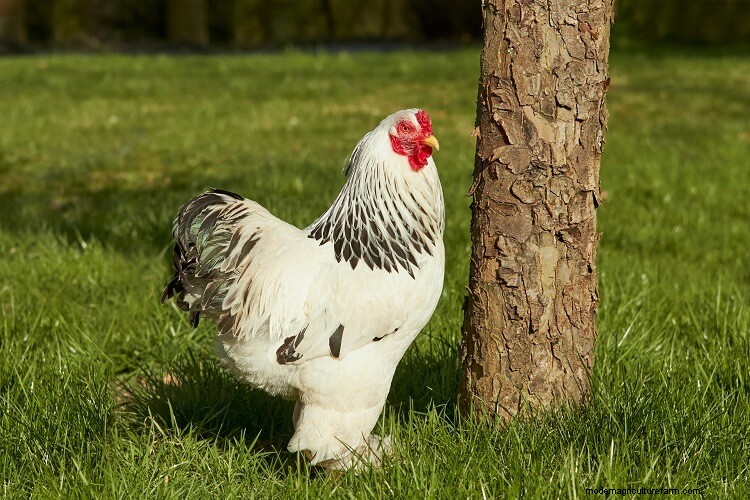
The Sussex is an ancient English hen and has been around for centuries.
They were kept as a dual purpose chicken and in their heyday supplied London with meat for the markets.
This is a dual purpose breed that will put out 4-5 large brown eggs a week. Hens are known for being a bit broody but they do make great mothers.
They do well in confinement but excel when allowed to free range and this will reflect in the feed bill (they are excellent scavengers).
Overall they are a mellow, low maintenance breed that is available in standard or bantam size and is suitable for kids or as a lap chicken.
| Sussex |
|---|
| Main Use: Dual Purpose |
| Yearly Egg Production: 250+ |
| Egg Color: Brown |
| Beginner Friendly: Yes |
| Temperament: Docile |
| Noise Level: Normal |
| Preferred Climate: Cold Hardy |
The Turken, also known as the Naked Neck, is a strange looking chicken.
They have no neck or hackle feathers and sparse feathering around their vent.
It is thought they originated from Transylvania, which explains their other nicknames:the Transylvanian naked neck or Kaalnek.
They like to forage and roam, but they will tolerate confinement. If they are allowed to range they are good foragers, active and vigorous. They are generally a placid and calm hen.
This breed does better in warmer areas but will be hardy enough in cold areas with some protection.
| Turken |
|---|
| Main Use: Dual Purpose |
| Yearly Egg Production: 100-170 |
| Egg Color: Brown |
| Beginner Friendly: No |
| Temperament: Friendly |
| Noise Level: Normal |
| Preferred Climate: Any |
The Vorwerk was created in Germany around the 1900s. Its purpose was as a dual breed breed.
It is a handsome chicken with black and buff plumage. A hen weighs around the 5lb mark with roosters around 7lb. They are fast to grow and mature and are very suitable for small farms and homesteads. She is winter hardy to most climates and available in both standard and bantam sizes.
The hens are decent layers of cream eggs – around 3 per week and they lay well throughout the winter. They do like to be active so free ranging is best for them as they are good foragers.
Vorwerks are a calm, docile and friendly hen which makes them good for novices and children.
| Vorwerk |
|---|
| Main Use: Dual Purpose |
| Yearly Egg Production: 100-170 |
| Egg Color: Cream |
| Beginner Friendly: Yes |
| Temperament: Bold (Self Assured) |
| Noise Level: Normal |
| Preferred Climate: Any |
Welsummers originated in Holland around the 1920s and remain very popular in Europe.
Here in the US they are gaining popularity as a dual purpose bird that is great for small farms and homesteads.
They are decent layers and produce 4-5 large dark brown eggs each week. The darkness of their eggs can rival some Marans.
The Welsummer will tolerate confinement but do best when free ranging as they are excellent foragers.
They are a low maintenance breed that is smart, curious and friendly with humans. They can be a bit raucous so urban living is not really for them.
| Welsummer |
|---|
| Main Use: Dual Purpose |
| Yearly Egg Production: 175-250 |
| Egg Color: Chocolate |
| Beginner Friendly: Yes |
| Temperament: Docile |
| Noise Level: Normal |
| Preferred Climate: Any |
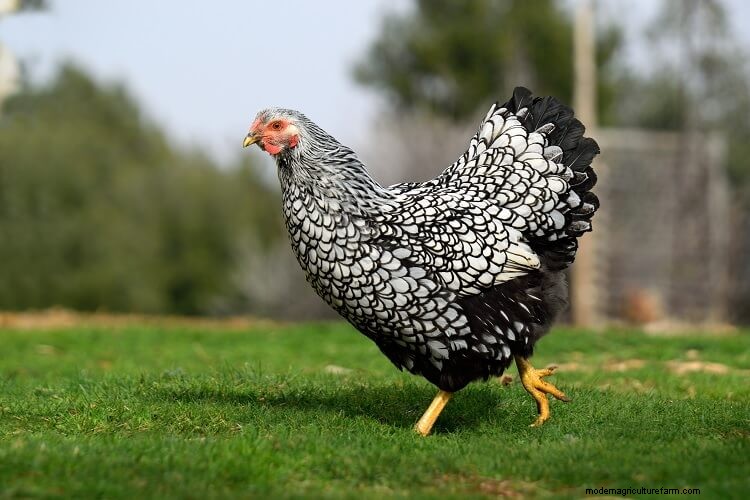
The Wyandotte chicken came into being in the late 1800s. It was created to be a dual purpose breed providing for both meat and eggs.
There is a wide range of varieties to the Wyandottes which we have mentioned here.
They are a large breed with hens weighing around 6lb and roosters around 8lb. The hens are good layers of light brown eggs, usually around 4 per week.
Wyandottes are an aloof chicken, friendly to a point but they do not really enjoy being picked up or held.
They are good for novices as they are low maintenance.
| Wyandotte |
|---|
| Main Use: Dual Purpose |
| Yearly Egg Production: 175-250 |
| Egg Color: Brown |
| Beginner Friendly: Yes |
| Temperament: Bold (Self Assured) |
| Noise Level: Quiet |
| Preferred Climate: Any |
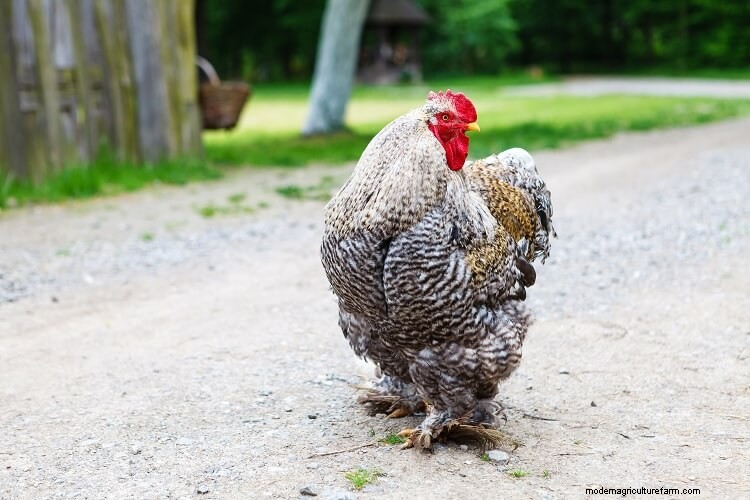
The Cochin was one of the breeds responsible for the hen fever of the late 1800s.
They were new and novel and were crossed with just about every breed known, giving us the richness of breeds that we see today. The Cochin is a large bird and is covered head to toe in feathers. They are slow moving so need to be kept safe from predators.
Their personality is friendly, calm and docile. They love to be lap chickens and adore children.
On the egg laying side, hens are not the best performers. However they do have a tendency towards broodiness so make great moms.
There are also Bantams available.
| Cochin |
|---|
| Main Use: Pet |
| Yearly Egg Production: 100-170 |
| Egg Color: Brown |
| Beginner Friendly: Yes |
| Temperament: Friendly |
| Noise Level: Quiet |
| Preferred Climate: Any |
Depending on which country you live in, the Frizzle may, or may not be a breed.
Here in the US they are not considered a breed but a feather variation of whichever breed they are hatched from (Polish and Cochins are quite prone to frizzles). Just remember that their feathers can be broken easily and the curling affects their ability to fly.
Their feathers curl up and away from the body, looking like a bad hair-do!
You can have your Frizzle in standard or bantam size.
They are a sweet and gentle breed that enjoys being with their humans and make very good show or exhibition birds.
This chicken is a good little forager who enjoys free ranging.
Egg laying will vary on the breed, but expect an average of 3 white eggs each week.
| Frizzle |
|---|
| Main Use: Pet |
| Yearly Egg Production: 100-170 |
| Egg Color: White |
| Beginner Friendly: Yes |
| Temperament: Friendly |
| Noise Level: Normal |
| Preferred Climate: Any |
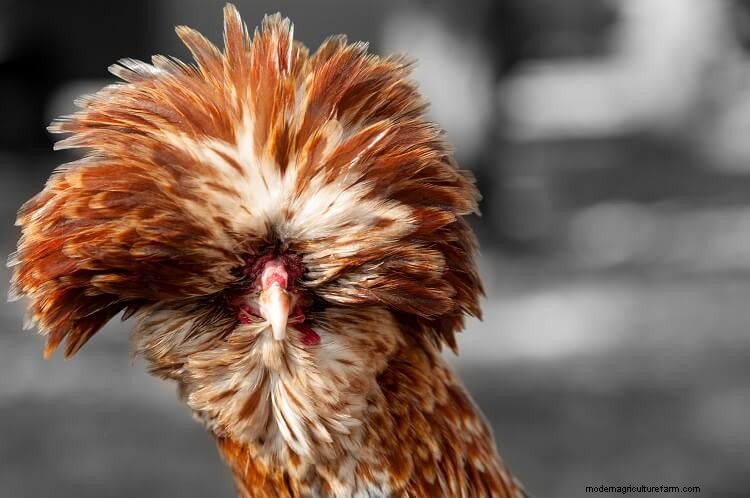
The Polish has an unmistakable appearance – the girls have pom pom hairdos and the boys look like bad hair days!
You may have heard this breed referred to as a Tophat or Paduan.
They are gentle, quiet, friendly and are well suited for children. They are mainly used for ornamental or show purposes these days, but they do lay fairly well. Hens can lay 3-4 large eggs each week.
Just remember that their head feathers can cause problems as they impinge upon the eyesight, so these chickens should be confined or supervised in free ranging.
| Polish |
|---|
| Main Use: Pet |
| Yearly Egg Production: 100-170 |
| Egg Color: White |
| Beginner Friendly: Yes |
| Temperament: Friendly |
| Noise Level: Normal |
| Preferred Climate: Any |
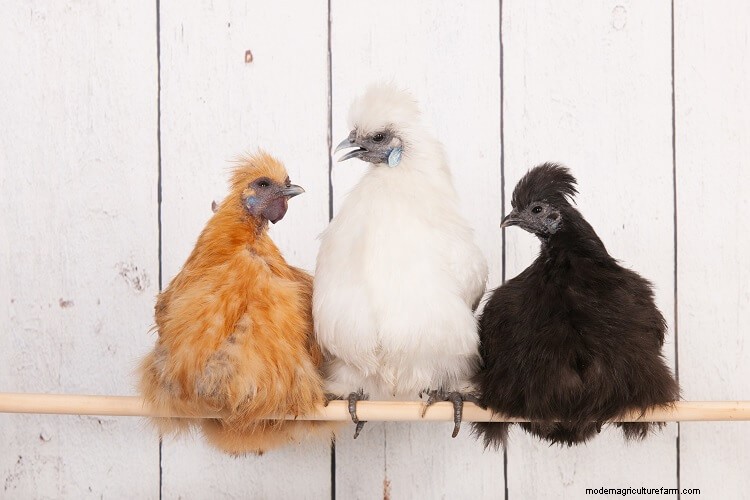
The Silkie is a much loved breed all over the world. Originating in China, this breed has become one of the most popular chickens of all time.
They are best known for their furry rather than feathered look. Kids just love to touch them as they also feel furry.
This breed makes for great pets since they love to cuddle, quiet and are very friendly. The hens are frequently used as broodies since they love to sit on eggs and they make very attentive mothers.
Since they cannot fly they are best confined or if left to free range they must be supervised.
Silkies come in a variety of colors and some have beards.
| Silkie |
|---|
| Main Use: Pet |
| Yearly Egg Production: 100-170 |
| Egg Color: Cream |
| Beginner Friendly: Yes |
| Temperament: Friendly |
| Noise Level: Quiet |
| Preferred Climate: Any |
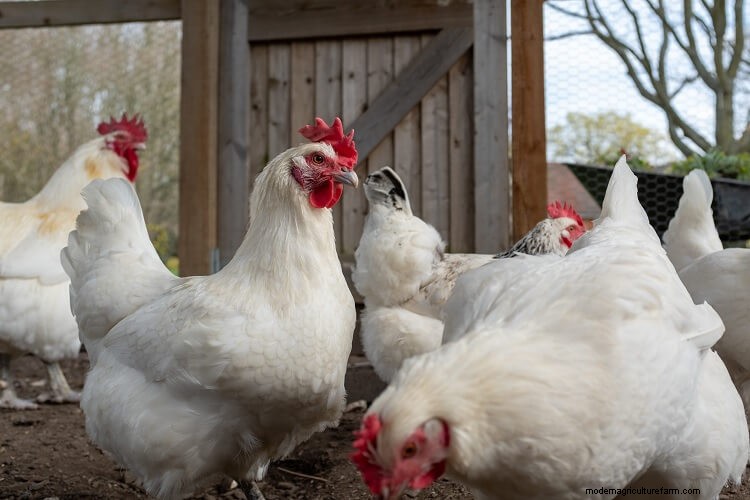
The Breese chicken originated in France and is the premier meat chicken in the world.
Raising this hen is very strictly controlled and only farmers that conform to the specifications are allowed to sell their chickens as Bresse.
The American Bresse has been around for a few years now. It is the same breed but cannot be called a Bresse as it would violate trade standards.
This chicken breed is primarily a meat breed however hens do lay a moderate amount of cream colored eggs each year.
There are some color variations, but the most well-known color is white. They can be flighty and aloof with people.
| Bresse |
|---|
| Main Use: Meat |
| Yearly Egg Production: 100-170 |
| Egg Color: Cream |
| Beginner Friendly: No |
| Temperament: Friendly |
| Noise Level: Normal |
| Preferred Climate: Any |
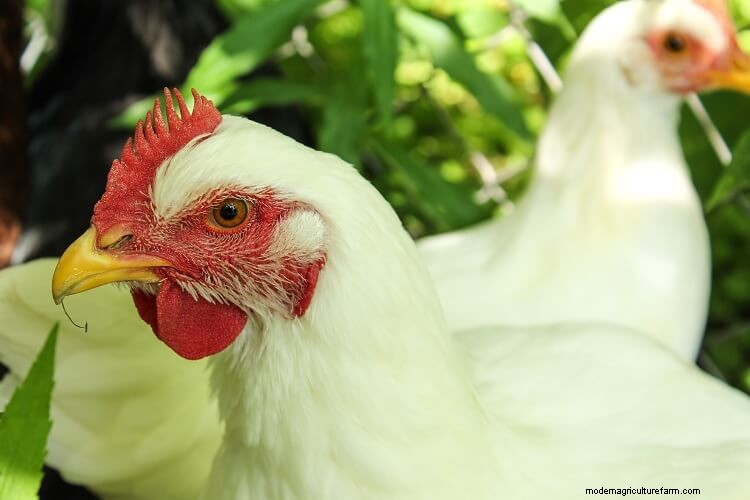
The Cornish Cross broiler was created by the poultry industry over 50 years ago and still dominates the meat market today.
This chicken is a cross between the commercial Cornish hen and a White Plymouth Rock.
Their growth rate is phenomenal so unfortunately they do not live much beyond six months.
Generally they are docile and calm. They do not forage but would rather hang out by the feeder. On the rare occasion that a hen lives to produce eggs, they will lay 2-3 small light brown eggs each week.
| Cornish Cross |
|---|
| Main Use: Meat |
| Yearly Egg Production: 100-170 |
| Egg Color: Brown |
| Beginner Friendly: No |
| Temperament: Docile |
| Noise Level: Quiet |
| Preferred Climate: Any |
Although often nicknamed Russians, this breed actually came from Persia.
However they gained popularity in the early 1800s by a Russian count named Orloff-Techesmensky.
They are more of a meat bird since the eggs are small and few in number.
As you might expect, they are well suited to cold climates and are found in several color varieties.
They are a calm and quiet chicken but not overly friendly or docile.
In the US they are rare and do not have a place in the American Poultry Association. Worldwide they are in need of conservation.
| Orloff |
|---|
| Main Use: Meat |
| Yearly Egg Production: 100-170 |
| Egg Color: Brown |
| Beginner Friendly: No |
| Temperament: Docile |
| Noise Level: Quiet |
| Preferred Climate: Cold Hardy |

Meet the first true bantam in this guide.
She originates from Belgium and is a popular choice for those without much space.
The Barbu D’Uccle is a delightfully friendly little hen that enjoys being held. She will frequently perch on your shoulder and talk to you – needless to say she is a perfect chicken for kids.
They come in a variety of colors with mille fleur being the most desirable. They have beards, muffs, vulture hocks and feathered feet, so an all round profusion of feathers!
The hens have a mixed reputation as layers. I have found them to lay (small cream eggs) fairly consistently through the warmer months shutting down for winter.
| Barbu d’Uccle |
|---|
| Main Use: Bantam |
| Yearly Egg Production: 175-250 |
| Egg Color: Cream |
| Beginner Friendly: Yes |
| Temperament: Friendly |
| Noise Level: Normal |
| Preferred Climate: Any |
These little chickens are true bantams.
They are known as Sablepoot in the UK and can be traced back to the sixteenth century.
They look similar to the Barbu d’Uccle with feathered feet and vulture hocks.
These hens are very friendly and calm and do well with children. They are good foragers, but really should be kept in a covered area for their own safety.
Hens weigh around 27oz and are good summer layers giving you 3 small white eggs each week.
| Booted Bantam |
|---|
| Main Use: Bantam |
| Yearly Egg Production: 100-170 |
| Egg Color: White |
| Beginner Friendly: Yes |
| Temperament: Friendly |
| Noise Level: Normal |
| Preferred Climate: Any |
Despite their name the Dutch bantam did not originate in Holland.
They are a true bantam and have no large counterpart.
Hens weigh a slight 14oz and there is plenty of variety with over 25 color variations.
The ladies are fair to moderate layers of small white eggs. They also make great broodies and are wonderful mothers.
When raised from chicks they can be very tame and friendly with a good temperament.
The breed is not particularly winter hardy, nor do they enjoy too much heat. They should have plenty of room as they are active and like to fly.
| Dutch Bantam |
|---|
| Main Use: Bantam |
| Yearly Egg Production: 100-170 |
| Egg Color: White |
| Beginner Friendly: Yes |
| Temperament: Docile |
| Noise Level: Normal |
| Preferred Climate: Any |
The Nankin is probably the oldest true bantam.
Records go back to the 1500s but the Nankin was known long before then.
This is a tiny breed weighing only 22-24oz and is unfortunately critically endangered worldwide.
She is a talkative, curious and social bird that likes to be active. They can be found with either a single or rose comb (better for cold climates). These little hens always range together as a flock to improve their chances of survival.
The hens will lay small cream eggs and are exceptional sitters, so much so that they are frequently used on English game farms to raise partridges.
| Nankin |
|---|
| Main Use: Bantam |
| Yearly Egg Production: 100-170 |
| Egg Color: Cream |
| Beginner Friendly: Yes |
| Temperament: Friendly |
| Noise Level: Normal |
| Preferred Climate: Any |
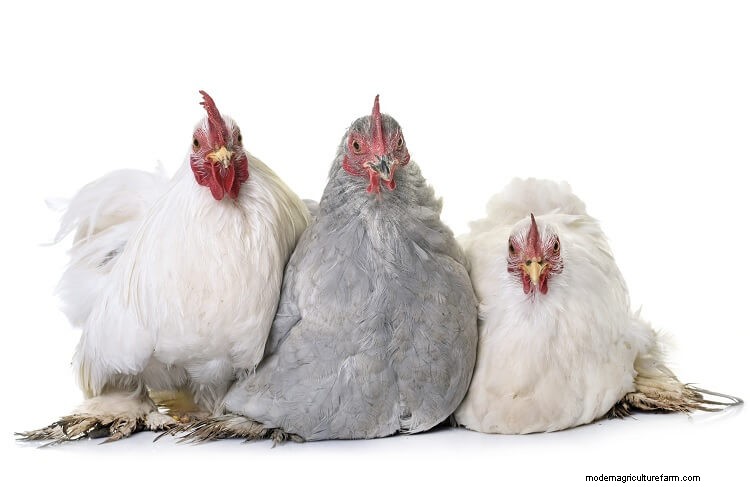
The Pekin bantam is a British breed that is known elsewhere as a Cochin bantam. As their name suggests, they are a true bantam and there is no standard counterpart.
They are well feathered, but despite all that feathering they really do not tolerate winters too well.
This bantam breed is gentle and docile but will only lay 2 small white eggs a week.
There are several color varieties to choose from and can become great pets (especially for children).
| Pekin Bantam |
|---|
| Main Use: Bantam |
| Yearly Egg Production: <100 |
| Egg Color: White |
| Beginner Friendly: Yes |
| Temperament: Friendly |
| Noise Level: Normal |
| Preferred Climate: Any |
The Sebright is a very distinctive chicken which was developed in the 1800s in England.
They are a true bantam and the oldest English bantam.
Interestingly the roosters are hen feathered which means there is no plumage difference in the sexes. The chicken has a rose comb and stunning plumage – there are two color varieties (gold and silver).
The hen will weigh in around 20oz and is a poor layer.
Unfortunately there is a high mortality rate for chicks in this breed making them difficult to raise – so not a hen for a novice.
These little birds are friendly, active and very social. Roosters are not known for aggression at all.
| Sebright |
|---|
| Main Use: Bantam |
| Yearly Egg Production: <100 |
| Egg Color: White |
| Beginner Friendly: No |
| Temperament: Friendly |
| Noise Level: Normal |
| Preferred Climate: Any |
The Serama owns the title of the smallest chicken in the world . These tiny chickens are generally under 500gm (17oz) but there are some that are only half this size.
Although they are small in stature they have a big personality.
This breed is friendly, gentle, loves human company and is quiet. They should be kept in confinement for their safety.
The Serama hen will lay 3-4 small eggs each week and likes to be broody.
| Serama |
|---|
| Main Use: Bantam |
| Yearly Egg Production: 100-170 |
| Egg Color: Cream |
| Beginner Friendly: No |
| Temperament: Friendly |
| Noise Level: Normal |
| Preferred Climate: Warm Climates |
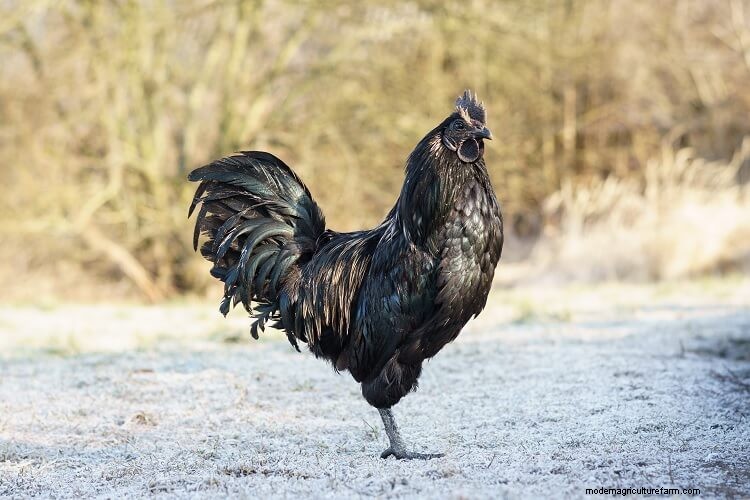
This all black melanistic chicken originated in the Indonesian Islands.
The melanoma means that everything is black:muscles, organs, heart and even the tongue!
Because they are black they are highly revered in their homeland where they are considered to have magical properties.
They are standard sized hens and weigh around 3.5-4.5lb.
The hens are cyclic egg layers which means they go through a cycle of laying eggs then stop for a while before resuming.
Because of this they are considered poor layers since they only put out around 80 cream colored eggs a year.
| Ayam Cemani |
|---|
| Main Use: Exhibition |
| Yearly Egg Production: <100 |
| Egg Color: Cream |
| Beginner Friendly: No |
| Temperament: Friendly |
| Noise Level: Normal |
| Preferred Climate: Warm Climates |
The Brabanter is another old and distinguished breed.
Their name comes from the Brabant area which covers part of Belgium and Holland.
There are both standard and bantam sizes available, but both are rare these days.
A standard hen weighs between 5-6lb and will lay white eggs in moderate amounts.
She is a shy chicken, but can be friendly. Roosters are highly strung.
| Brabanter |
|---|
| Main Use: Exhibition |
| Yearly Egg Production: 100-170 |
| Egg Color: White |
| Beginner Friendly: Yes |
| Temperament: Docile |
| Noise Level: Normal |
| Preferred Climate: Any |
The Crevecoeur is an ancient French breed that is now critically endangered.
It was originally a dual purpose breed and can still be used as such, but today it is mainly an ornamental breed.
They have an all black plumage with a head crest that almost hides the rooster V shaped comb. They are a medium sized standard chicken with hens weighing around 6.5lb.
Hens are moderate layers of medium sized white eggs (roughly 3 each week).
Their personality is calm, docile and active. They do tolerate confinement fairly well, but enjoy free ranging too.
| Crevecoeur |
|---|
| Main Use: Exhibition |
| Yearly Egg Production: 100-170 |
| Egg Color: White |
| Beginner Friendly: Yes |
| Temperament: Docile |
| Noise Level: Quiet |
| Preferred Climate: Any |
The Cubalaya was developed in Cuba from Filipino poultry.
It has a pea comb and a very distinctive lobster tail.
They were used for cock fighting in their homeland as roosters are known for being aggressive. However towards people, the Cubalaya is friendly, curious and remarkably tame.
In the US this breed is thought of as an ornamental breed.
As you would expect they tolerate high heat and humidity well but do not do well in cold climates.
The Cubalaya is not a large hen at only around 4lb.
| Cubalaya |
|---|
| Main Use: Exhibition |
| Yearly Egg Production: 175-250 |
| Egg Color: Cream |
| Beginner Friendly: Yes |
| Temperament: Friendly |
| Noise Level: Loud |
| Preferred Climate: Warm Climates |
This particular breed is thought to have been in existence for around 3000 years! It comes from south western Egypt where it has thrived in the hot climate.
They are tough, independent, noisy and can fly very well.
As you may imagine they do not do well in confinement, it makes them more nervous and they start to feather pick each other.
If raised from chicks you can get them to be accepting of you, but they are not a very social breed where humans are concerned.
The Fayoumi is a small chicken that will only weigh 3.5lb.
They will lay 3 small tinted eggs per week and are not known for being broody.
| Egyptian Fayoumi |
|---|
| Main Use: Exhibition |
| Yearly Egg Production: 100-170 |
| Egg Color: White |
| Beginner Friendly: No |
| Temperament: Quarrelsome (Aggressive) |
| Noise Level: Loud |
| Preferred Climate: Warm Climates |
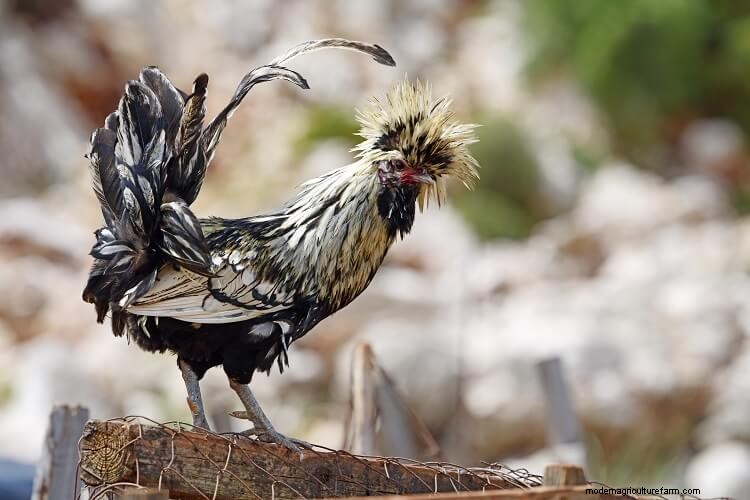
The Houdan is a very old breed that came from France.
They are considered unusual because they have a crest, beard and five toes. Their comb is also unusual as it is a V shape. They were once widely kept as dual purpose hens, but nowadays are more ornamental or exhibition birds.
Do not expect many eggs with this breed as they will only give 2-3 small eggs a week. They are non-setters, but older hens can have a tendency towards broodiness.
Overall this is a docile and sweet chicken that enjoys lap time and is good with kids.
| Houdan |
|---|
| Main Use: Exhibition |
| Yearly Egg Production: 100-170 |
| Egg Color: White |
| Beginner Friendly: Yes |
| Temperament: Docile |
| Noise Level: Quiet |
| Preferred Climate: Any |
The Malay chicken is certainly not for everyone.
This is an unruly chicken prone to picking on other breeds – they will even feather pluck their own if confined.
They are a game bird (hence the crabby temperament) and were widely used back in the 1900s to create or invigorate other breeds.
These days the Malay is considered to be an ornamental or show bird. The hens are poor layers, so if you get one egg a week you will be lucky.
As they originate from Indonesian they are tolerant of heat, not so much the cold though!
| Malay |
|---|
| Main Use: Exhibition |
| Yearly Egg Production: <100 |
| Egg Color: Brown |
| Beginner Friendly: No |
| Temperament: Quarrelsome (Aggressive) |
| Noise Level: Normal |
| Preferred Climate: Warm Climates |
The Old English Game has remained virtually unchanged for 2000 years!
Unfortunately it was introduced to Britain by the Romans for cock fighting. However since cock fighting is now illegal, it is used as a show or exhibition bird.
This breed cannot be kept with other fowl as it will fight them – even the hens will fight.
Roosters should be separated out at six months or they will fight to the death.
Surprisingly though, they can be friendly and talkative with their humans.
| Old English Game |
|---|
| Main Use: Exhibition |
| Yearly Egg Production: 100-170 |
| Egg Color: Cream |
| Beginner Friendly: No |
| Temperament: Quarrelsome (Aggressive) |
| Noise Level: Loud |
| Preferred Climate: Any |
This breed is for those who have the time, energy and devotion to care for them.
The Onagadori is an ancient breed from Japan where it enjoys a special historical status.
They are friendly, calm, docile and are primarily used for shows.
Onagadori literally means long tail in Japanese, and they are kept for these tails. The longest tail ever recorded was a stunning 88 feet.
These chickens need special accommodations and care and should be kept by themselves to prevent damage to their tails.
| Onagadori |
|---|
| Main Use: Exhibition |
| Yearly Egg Production: 100-170 |
| Egg Color: White |
| Beginner Friendly: No |
| Temperament: Docile |
| Noise Level: Quiet |
| Preferred Climate: Warm Climates |
The Phoenix is a German creation that came into being around the 1800s.
They are a cross between several Japanese long tailed breeds and several German breeds.
Interestingly the Phoenix molts their tail each year.
It is a beautiful breed with a good personality – they are alert, docile, gentle and talkative. They are known to be friendly and can become good pets.
Today they are mainly used as show breeds and there are several color varieties to choose from.
| Phoenix |
|---|
| Main Use: Exhibition |
| Yearly Egg Production: <100 |
| Egg Color: Cream |
| Beginner Friendly: No |
| Temperament: Friendly |
| Noise Level: Normal |
| Preferred Climate: Any |
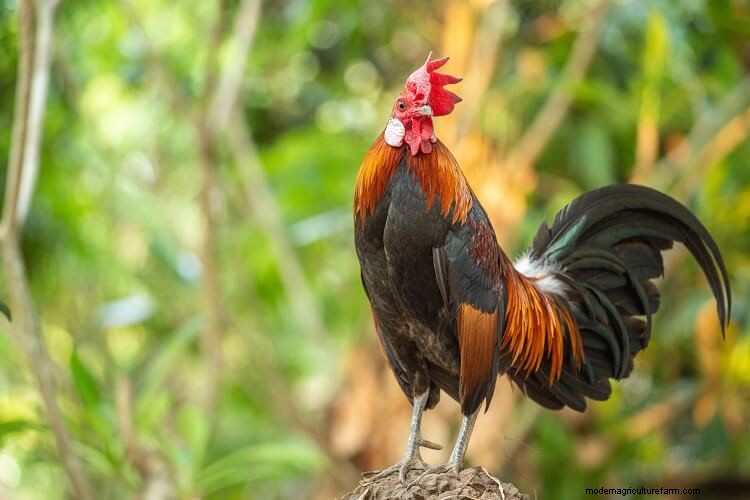
Meet the breed that started it all.
The Red Jungle fowl is an ancestor of pretty much every chicken we see today.
They were captured and semi-domesticated around 8000 years ago by humans. They still roam freely in areas of the Far East from Thailand down to the Indonesian islands. To this day they remain wary of humans and avoid contact if possible.
This breed does not like being handled and if allowed to free range will wander far and wide.
The Jungle fowl is a smallish chicken with hens reaching only 2¼lb.
| Red Jungle Fowl |
|---|
| Main Use: Exhibition |
| Yearly Egg Production: <100 |
| Egg Color: White |
| Beginner Friendly: No |
| Temperament: Bold (Self Assured) |
| Noise Level: Normal |
| Preferred Climate: Warm Climates |
The Shamo is an Asian breed and was originally raised as a fighting bird. They are a tall chicken with muscular thighs and body, a small pea comb and very small or non-existent wattles.
This chicken is actually a strain of the Asian Asil (Aseel). There are four varieties of Shamo with the heaviest rooster weighing around 12lb.
A chicken like this requires special handling and accommodations.
Even the hens can be aggressive with other breeds and roosters will fight and kill other chickens. This aggressive trait can also be problematic with the chicks – they may fight and kill each other.
Hens are poor layers giving you perhaps 2 light brown medium sized eggs per week.
These birds are not for novices and definitely not children.
| Shamo |
|---|
| Main Use: Exhibition |
| Yearly Egg Production: <100 |
| Egg Color: Brown |
| Beginner Friendly: No |
| Temperament: Quarrelsome (Aggressive) |
| Noise Level: Normal |
| Preferred Climate: Warm Climates |
The Sultan is the ultimate in show chickens .
This chicken has it all:V comb, crest, beard and muffs, vulture hocks, feathered feet, a long tail and five toes.
Originally they are from Turkey where they were known as the Serai Taook or Sultans fowl. They were allowed to roam the grounds of the palace because they did not scratch up the dirt or grass.
They are a calm, docile and very friendly hen well suited to pet status. They like to be active but should be either confined or supervised whilst free ranging.
Unfortunately they are critically endangered according to the Livestock Conservancy.
| Sultan |
|---|
| Main Use: Exhibition |
| Yearly Egg Production: <100 |
| Egg Color: White |
| Beginner Friendly: No |
| Temperament: Docile |
| Noise Level: Quiet |
| Preferred Climate: Warm Climates |
The Sumatra was originally imported from Indonesia where it can still be found today.
They were originally used as a fighting bird and although the males can be aggressive during the mating season, it is rare to find them fighting to the death. Out of mating season they are relatively calm.
This is not a breed that tolerates confinement. They are active, restless and fly well. They can be easily handled by their humans.
The hens weigh around 4lb and are variable layers (strain dependant).
Their main use today is as an ornamental breed and they can be found in bantam size also.
| Sumatra |
|---|
| Main Use: Exhibition |
| Yearly Egg Production: <100 |
| Egg Color: White |
| Beginner Friendly: No |
| Temperament: Skittish |
| Noise Level: Normal |
| Preferred Climate: Any |
The Thuringian comes from the Thuringian Forest area of Germany and has been documented since the mid-1700s.
This is a rare chicken although their popularity seems to be increasing.
They are considered to be a dual purpose breed but now they are mainly kept for eggs and exhibition. Hens will lay 3 white eggs each week and rarely go broody – if they do, they make good mothers.
There are several color varieties to choose from and they are all bearded with muffs.
Overall this is a confident, active, talkative and very friendly chicken that would be ideal for children.
| Thuringian |
|---|
| Main Use: Exhibition |
| Yearly Egg Production: 100-170 |
| Egg Color: White |
| Beginner Friendly: No |
| Temperament: Bold (Self Assured) |
| Noise Level: Normal |
| Preferred Climate: Any |
This ancient breed can be traced back about 1500 years!
The breed we see today was developed in Japan and is considered an historical artifact in Japan.
They belong to the long crowing family and roosters can hold their crow for up to 25 seconds.
Boys also have long tails that can grow up to 4 feet, so special accommodations are required for this breed.
Hens are poor layers producing 2 white eggs each week.
Personality wise they are known for being gentle and talkative. Their plumage is all black with a green sheen in the light.
Tomarus are kept mainly for exhibition in the west, but in the Far East there are crowing contests for which these chickens are kept.
| Tomaru |
|---|
| Main Use: Exhibition |
| Yearly Egg Production: <100 |
| Egg Color: White |
| Beginner Friendly: No |
| Temperament: Docile |
| Noise Level: Loud |
| Preferred Climate: Warm Climates |
The White Faced Black Spanish, also known as Cara Blanca, hails from Spain and is an old breed possibly dating back to the 1500s.
Sadly these days she is critically endangered.
This breed is mainly kept for eggs and ornamental purposes. They certainly stand out from the crowd with their white clown faces . The hens are decent layers, producing 3 large white eggs a week.
They are independent and do not like to be picked up or held. You can expect a noisy flighty chicken that likes to free range and forage.
This breed is rather slow to mature and can take a year to reach adulthood.
White Faced Black Spanish are available in standard or bantam size.
| White Faced Black Spanish |
|---|
| Main Use: Exhibition |
| Yearly Egg Production: 100-170 |
| Egg Color: White |
| Beginner Friendly: No |
| Temperament: Skittish |
| Noise Level: Loud |
| Preferred Climate: Warm Climates |
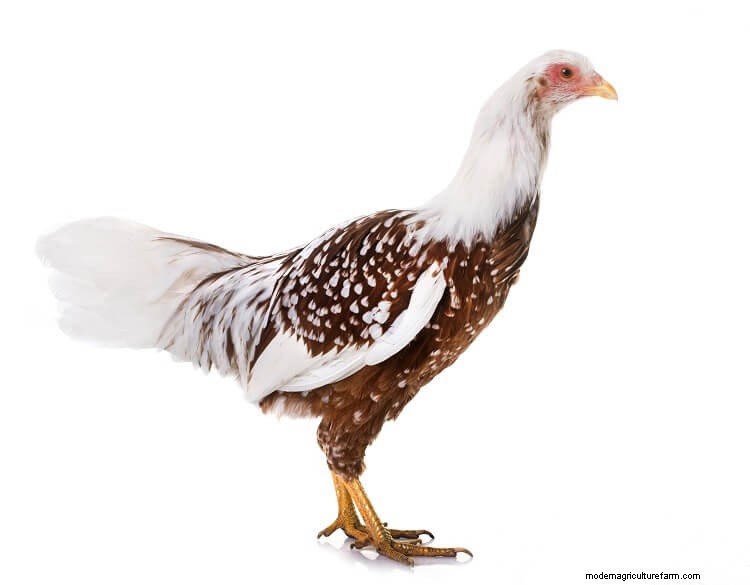
Despite the name, the Yokohama was created in Germany from Japanese parents back in the 1880s. Today it is critically endangered and in need of support.
It is bred for exhibition, show and ornamental uses only.
This is a small breed that is bred for their incredibly long tails (they can grow up to 3 feet each year).
They love to free range as they are an active bird that is always alert for danger.
Overall they are a low maintenance bird that is easy to handle and can become docile and friendly in time.
| Yokohama |
|---|
| Main Use: Exhibition |
| Yearly Egg Production: <100 |
| Egg Color: Cream |
| Beginner Friendly: Yes |
| Temperament: Docile |
| Noise Level: Quiet |
| Preferred Climate: Any |
Chickens are one of the easiest livestock animals to care for and fit well into a small space if need be.
We hope you have enjoyed looking through our chicken breed list.
Hopefully it has helped you to decide what you want in your coop.
Our aim was to let you know what is available and what sort of chickens there are so that you do not end up with a hen that is of no practical use to you.
Did we miss your favorite breed? Fatecelo sapere nella sezione commenti qui sotto...